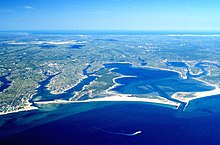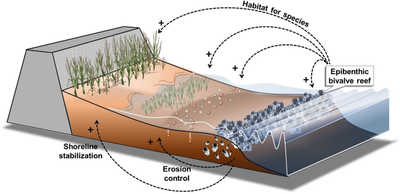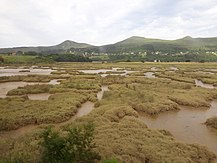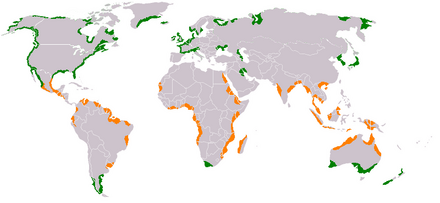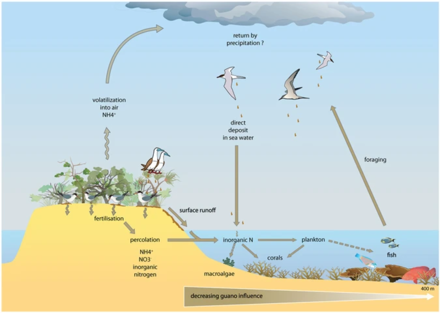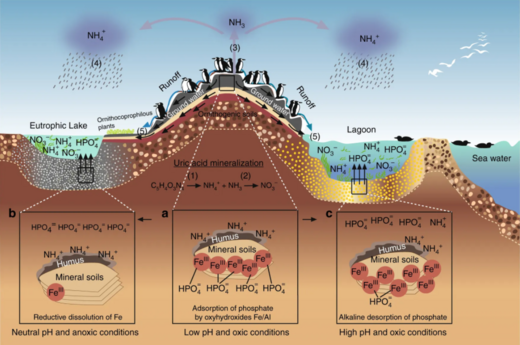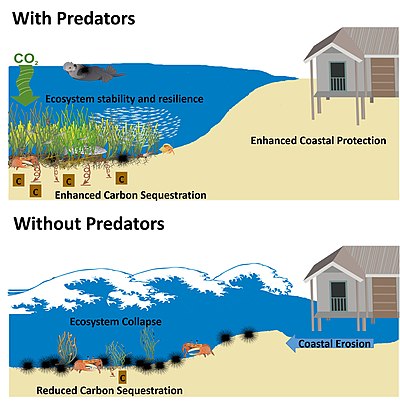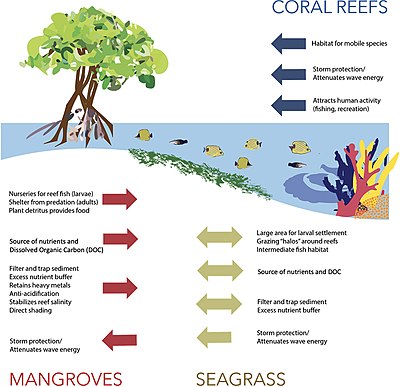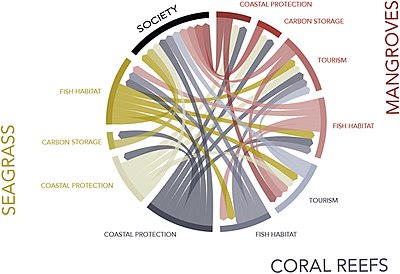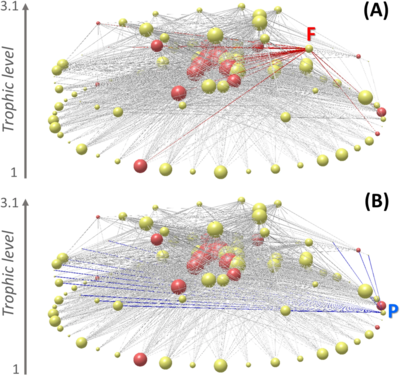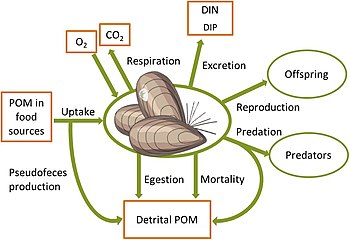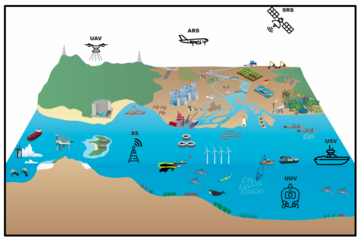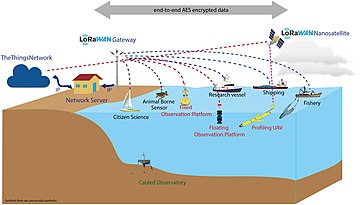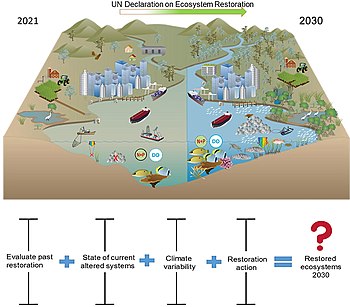해양해안생태계
Marine coastal ecosystem| 해양 서식지 |
|---|
 |
해양연안생태계는 육지가 바다와 만나는 곳에서 발생하는 해양생태계다.해양 해안 생태계에는 해초와 라군, 소금 습지와 맹그로브 숲, 해초와 산호초, 다시마 숲과 백워터 등 다양한 해양 서식지가 있다.직간접적으로 이러한 것들은 탄소를 격리하고, 영양소와 원소를 순환시키고, 상업적 어업을 위한 양묘장과 어장을 제공하고, 해안 침식을 방지하고 극단적인 사건을 완화하며, 레크리에이션 서비스를 제공하고, 관광을 지원하는 등 인간을 위한 광범위한 생태계 서비스를 제공한다.
개요
해안 바다는 매우 생산성이 높은 시스템으로, 육지에서 나오는 영양분 유출물의 처리와 기후 규제와 같은 일련의 생태계 서비스를 인류에게 제공한다.[1]그러나 연안 생태계는 기후변화와 영농화 등 인간이 유발하는 압력에 의해 위협받고 있다.연안 지역에서, 영양소의 유동과 변화, 그리고 해안 생태계 기능과 서비스를 지탱하는 탄소가 벤틱(즉, 해저에서 발생하는) 생물학적, 화학적 과정에 의해 강력하게 규제된다.[1]
해안 시스템은 또한 육지에서 배출되는 인공 배출물을 바다에 도달하기 전에 효율적으로 처리함으로써 기후와 영양소 순환의 규제에 기여한다.[2][3][4][5]세계 인구의 상당 부분이 해안 가까이 살고 있다는 점을 감안하면 이들 생태계 서비스의 높은 가치는 분명하다.[6][7][1]
현재 전 세계 해안 바다는 기후변화, 인공영양소 투입, 남획, 침습종 확산 등 인간이 일으키는 압력에 의해 추진되는 주요한 생태적 변화를 겪고 있다.[8][9]많은 경우에, 이러한 변화는 새로운 상태를 달성하고 기준선이 이동될 정도로 기본적인 생태학적 기능을 변화시킨다.[10][11][1]
유엔은 2015년 2030년까지 특정 목표 달성을 목표로 17개의 지속가능발전목표를 수립했다.그들의 14번째 목표인 "물 아래 생명"에 대한 사명은 "지속 가능한 발전을 위해 해양, 해양, 해양 자원을 안정적이고 지속적으로 사용하는 것"[12]이다.유엔도 2021~2030년 '유엔 생태계 복원 10년'을 선포했지만 해안 생태계 복원은 적절한 관심을 받지 못하고 있다.[13]
해안 서식지
인터티드존
인터티드존은 썰물 때 눈에 보이고 공기에 노출되고 만조 때 소금물로 뒤덮인 지역이다.[14]서로 다른 특징과 야생동물을 가지고 있는 서로 다른 네 개의 물리적 분열이 있다.이 중분류는 스프레이 존, 고간격존, 중간간격존, 저간격존이다.스프레이 존(Spray zone)은 보통 바닷가에만 도달하고 높은 조수나 폭풍에 의해서만 물에 잠기는 습한 지역이다.고산간격지대는 만조 때는 물에 잠기지만 고조간에는 오랜 기간 건조 상태를 유지한다.[14]이 지역은 조건의 편차가 크기 때문에, 바나클, 바다 달팽이, 홍합, 소라게와 같은 이러한 변화에 견딜 수 있는 복원력이 있는 야생 동물들이 서식하고 있다.[14]조수는 하루에 두 번 중간상륙지대를 흐르는데 이 지역은 야생동물의 종류가 더 많다.[14]최저 조수 때를 제외하고 거의 항상 낮은 조수간만의 차가 잠기고 물이 주는 보호로 이곳 생활이 더욱 풍성하다.[14]
에스투아리아스
염류와 담수원 사이에 염분 변화가 눈에 띄게 나타나는 곳이 발원한다.이것은 일반적으로 강이 바다나 바다와 만나는 곳에서 발견된다.이 지역의 물은 고사리류여서 강에서 발견되는 야생동물은 독특하다 - 바다로 흘러가는 담수와 짠 바닷물이 섞여 있다.[15]다른 종류의 하수도 존재하며 전통적인 고사리 하구와 비슷한 특징을 가지고 있다.오대호가 대표적인 예다.그곳에서 강물은 호수물과 섞이고 담수저류지를 만든다.[15]하류는 많은 인간과 동물 종이 다양한 활동을 위해 의존하는 극도로 생산적인 생태계다.[16]이는 세계 32대 도시 중 22개 도시가 많은 종에게 중요한 서식지, 그리고 많은 해안 지역사회를 위한 경제적 중심지 등 많은 환경적, 경제적 이점을 제공하기 때문에 강가에 위치해 있다고 볼 수 있다.[16]에스테리어는 또한 정수 여과, 서식지 보호, 침식 관리, 가스 규제 영양소 순환과 같은 필수적인 생태계 서비스를 제공하고, 사람들에게 교육, 휴양, 관광 기회까지 제공한다.[17]
라건스
라군(lagoon)은 산호초나 모래톱과 같은 자연적인 장벽에 의해 더 큰 물과 분리된 지역이다.라군에는 해안 라군과 해양/대양 라군 두 종류가 있다.[18]해안의 석호는 위의 정의와 같이 방벽에 의해 바다로부터 분리되어 있는 단순한 물체다.환초는 석호를 둘러싸고 있는 원형의 산호초나 여러 개의 산호섬이다.아톨라곤은 종종 해안 라곤보다 훨씬 더 깊다.[19]대부분의 라군들은 강수량, 증발량, 바람의 변화에 의해 크게 영향을 받는다는 매우 얕은 의미를 지닌다.염분과 온도는 라군에서 매우 다양하며 신선한 물에서 초살린에 이르는 물을 섭취할 수 있다는 뜻이다.[19]라궁은 남극을 제외한 모든 대륙의 전 세계 해안에서 발견될 수 있으며, 새, 물고기, 게, 플랑크톤 등을 포함한 다양한 종의 서식처다.[19]라군들은 다양한 종의 서식지일 뿐만 아니라 광범위한 생태계 서비스를 제공하기 때문에 경제에도 중요하다.이러한 서비스들 중 일부는 어업, 영양소 순환, 홍수 보호, 물 여과, 심지어 인간의 전통까지 포함한다.[19]
암초
산호초
산호초는 세계에서 가장 잘 알려진 해양 생태계 중 하나로, 가장 큰 것은 대보초다.이 산호초들은 함께 사는 다양한 종의 큰 산호 군락으로 이루어져 있다.주변의 유기체들과 여러 공생관계에서 나온 산호들.[20]산호초는 지구 온난화의 영향을 많이 받고 있다.그들은 가장 취약한 해양 생태계 중 하나이다.온난화 수준이 높은 해양 열파 때문에 산호초는 큰 감소, 중요한 구조물의 손실, 높은 해양 열파에 노출될 위험이 있다.[21]
- 수줍어하면서도 위협적인 듀공이 해초밭을 파헤치며 재발을 부추긴다.
쌍봉 암초
이발브 암초는 침식관리와 해안안정화를 통해 해안 보호를 제공하고, 생태공학에 의해 물리적 경관을 변형하여 갯벌 벤트릭 공동체, 해초, 습지 등 다른 서식지와의 원활한 상호작용을 통해 종의 서식지를 제공한다.[23]
식물인간

오른쪽에 있는 도표에서 보듯이 식물성 해안 생태계가 전 세계적으로 발생한다.해초 침대는 차가운 극지방에서 열대지방까지 발견된다.맹그로브 숲은 열대 및 아열대 지역에 국한되어 있는 반면, 조석 습지는 모든 지역에서 발견되지만 가장 흔히 온대 지역에서 발견된다.이 생태계를 합치면 약 5천만 헥타르에 이르며, 높은 탄소 격리율뿐만 아니라 어업 생산, 해안선 보호, 오염 완충과 같은 다양한 생태계 서비스를 제공한다.[25][24]
토지 이용 변화를 통한 식물성 연안 생태계의 급격한 손실은 수세기 동안 발생했으며, 최근 수십 년 동안 가속화되었다.서식지 전환의 원인은 세계적으로 다양하며, 양식업, 농업, 산림과다폭발, 산업용, 상류댐, 준설, 해발고도 상승과 침하 가속화에 따른 상류의 어영토화, 도시개발, 개방수로의 전환 등이 있다.[25][24]
식물화된 해안 생태계는 일반적으로 수 미터 깊이의 유기농 퇴적물 위에 존재하며, 저산소 조건과 심층 분해를 억제하는 다른 요인들로 인해 탄소를 효과적으로 잠글 수 있다.[26]이들 탄소주는 삼림을 포함한 지상 생태계의 것을 몇 배 이상 뛰어넘을 수 있다.[27][28]해안 서식지가 퇴화되거나 다른 토지 이용으로 전환되면 퇴적탄소가 불안정해지거나 산소에 노출되며, 이후 증가된 미생물 활동으로 대량의 온실가스가 대기권이나 물기둥에 방출된다.[29][26][30][31][32][33]저장된 해안 청색 탄소를 대기 중으로 방출함으로써 발생하는 잠재적인 경제적 영향은 전 세계적으로 감지된다.일반적으로 온실 가스 배출의 경제적 영향은 가뭄, 해수면 및 극한 기후 사건의 빈도 증가와 관련이 있다.[34][24]
해안 습지
해안 습지는 지구상에서 가장 생산적인 생태계에 속하며 전 세계 인간 사회에 도움이 되는 중요한 서비스를 만들어 낸다.소금 습지, 맹그로브와 같은 습지에 의한 침전물 안정화는 폭풍, 홍수, 토지 침식으로부터 해안 공동체를 보호하는 역할을 한다.[39]해안 습지대는 또한 인간쓰레기로 인한 오염을 줄이고,[40][41] 물기둥의 과잉 영양분을 제거하며,[42] 오염물질을 가두며,[43] 탄소배출을 억제한다.[44]게다가, 근해 습지는 다양한 경제적 중요 종들을 지원하면서, 놀이 물고기의 필수적인 유아 서식처와 먹이 먹이로 작용한다.[45][46][47][48][49]
맹그로브 숲
맹그로브는 열대나 아열대 위도의 해안선 근처의 저산소 토양에서 자라는 나무나 관목이다.[50]그들은 육지와 바다를 연결하는 극도로 생산적이고 복잡한 생태계다.맹그로브는 반드시 서로 관련이 없는 종으로 구성되어 있으며, 유전적 유사성보다는 그들이 공유하는 특성에 따라 분류되는 경우가 많다.[51]해안과 가깝기 때문에, 그들은 모두 소금 배설을 하고, 산소가 고갈된 짠 물에서 살 수 있는 뿌리 자생술과 같은 적응법을 개발했다.[51]맹그로브는 폭풍의 파도, 조류, 파도와 조수의 침식을 감소시킴으로써 해안을 보호하는 작용을 하는 빽빽한 뿌리들의 뒤엉킨 것으로 종종 알아볼 수 있다.[50]맹그로브 생태계는 또한 많은 종들에게 중요한 식량의 공급원이 될 뿐만 아니라 지구적인 맹그로브 탄소 저장고로 대기의 이산화탄소를 격리시키는데 탁월한 능력을 가지고 있다. 연간 3,400만 미터 톤으로 추산된다.[51]
소금이 습하다.
소금 습지는 바다에서 깨끗한 물과 소금물이 혼합된 육지로의 전환이다.[52]이러한 습지의 흙은 종종 진흙과 피트라고 불리는 유기 물질 층으로 이루어져 있다.피트는 수분이 많고 뿌리가 가득 찬 부패 식물 물질로, 종종 낮은 산소 농도(저산소증)를 유발하는 것이 특징이다.이러한 저산소 조건들은 또한 소금을 주는 박테리아의 성장을 유발하여 그들이 흔히 알고 있는 유황 냄새를 습지시킨다.[53]소금 습지는 전 세계에 존재하며 건강한 생태계와 건강한 경제에 필요하다.그들은 매우 생산적인 생태계로서 어종의 75% 이상을 위해 필수적인 서비스를 제공하고 침식과 홍수로부터 해안선을 보호한다.[53]소금 습지는 일반적으로 고습지, 저습지, 고지대 국경지대로 나눌 수 있다.저습지는 저조를 제외한 거의 모든 조수에서 침수되는 등 바다와 더 가깝다.[52]높은 습지는 낮은 습지와 고지 경계선 사이에 위치하며 보통 평소보다 높은 조수가 존재할 때만 범람한다.[52]고지 경계선은 습지의 담수 가장자리로 보통 높은 습지보다 약간 높은 고도에 위치한다.이 지역은 보통 극심한 기후 조건에서만 침수되며 다른 습지 지역보다 침수 조건과 염분 스트레스를 훨씬 덜 경험한다.[52]
씨그라스 초원
씨그래스는 세계에서 가장 생산성이 높은 생태계 중 하나인 밀도 높은 수중 초원을 형성한다.그들은 산호초에 버금가는 다양한 해양 생물을 위한 서식지와 먹이를 제공한다.여기에는 새우나 게 같은 무척추동물, 대구와 광어, 해양 포유류, 조류 등이 포함된다.그들은 해마, 거북이, 듀공과 같은 멸종 위기에 처한 종들을 위해 조류를 제공한다.그들은 새우, 가리비, 그리고 많은 상업 어종의 유아 서식지 역할을 한다.씨그라스 초원은 잎이 해안에 부딪칠 때 파도의 에너지를 흡수하는 방식으로 해안 폭풍 보호를 제공한다.박테리아와 영양분을 흡수해 해안가 바다를 건강하게 유지하고, 해저의 침전물에 이산화탄소를 격리시켜 기후변화의 속도를 늦춘다.
씨그래스는 육지를 식민지화하고 육지식물이 된 해조류로부터 진화했고, 약 1억년 전에 바다로 돌아왔다.그러나 오늘날 해초는 육지 유출로 인한 오염, 풀밭을 가로지르는 준설선이나 트롤을 끄는 어선, 생태계 균형이 맞지 않는 남획 등 인간의 활동에 의해 훼손되고 있다.씨그라스 초원은 현재 매시간 약 2개의 축구장 비율로 파괴되고 있다.
다시마 숲
다시마 숲은 온대와 극지방의 해안에서 전세계적으로 발생한다.[54]2007년에는 에콰도르 인근 열대 해역에서도 다시마 숲이 발견되었다.[55]
갈색 매크로에 의해 물리적으로 형성된 다시마 숲은 해양 생물의[56] 독특한 서식지를 제공하고 많은 생태적 과정을 이해하는 원천이다.지난 세기에 걸쳐, 그들은 특히 영양 생태계에 있어서 광범위한 연구의 초점이 되어왔고, 이 독특한 생태계를 넘어 관련성이 있는 중요한 아이디어들을 계속해서 도발하고 있다.예를 들어, 다시마 숲은 해안 해양학 패턴에[57] 영향을 줄 수 있고 많은 생태계 서비스를 제공할 수 있다.[58]
그러나 인간의 영향은 종종 다시마 숲의 퇴화에 기여했다.특히 우려되는 것은 연안 생태계의 남획으로 인한 영향인데, 이는 초식동물을 그들의 정상적인 개체군 규제에서 해방시켜 다시마와 다른 해조류의 과열을 초래할 수 있다.[59]이것은 상대적으로 적은 종들이 지속되는 불모의 풍경으로 빠르게 전환되는 결과를 초래할 수 있다.[60][61]이미 남획과 기후변화의 복합적인 영향으로 다시마 숲은 태즈메이니아의 동쪽 해안과 북부 캘리포니아 해안과 같이 특히 취약한 많은 곳에서 거의 사라졌다.[62][63]해양 보호 구역의 구현은 어업으로 인한 영향을 제한하고 다른 환경 스트레스 요인의 부가적인 영향으로부터 생태계를 완충시킬 수 있기 때문에 이러한 문제를 해결하는 데 유용한 하나의 관리 전략이다.
해안생태학
해안먹이사슬
| 외부 영상 | |
|---|---|
– 데이비드 아텐버러, 넷플릭스 풀 에피소드 |
연안에는 강과 대륙붕 위의 물이 포함된다.그들은 전체 해양 면적의 약 8%를 차지하며 전체 해양 생산성의 약 절반을 차지한다.영농화를 결정하는 주요 영양소는 해안가의 질소와 호수의 인이다.둘 다 주변 바다나 인접 호수의 비료 역할을 하는 과노(seabird shat)에서 고농도로 발견된다.요산은 지배적인 질소 화합물로, 광물화 과정에서 다른 질소 형태가 생성된다.[65]
생태계는, 심지어 겉으로 보기에 뚜렷한 경계를 가진 것들도, 다른 인접한 시스템들과 독립적으로 기능하는 경우는 거의 없다.[66]생태학자들은 에너지와 영양소의 교차생태계 수송이 식물과 동물의 개체수와 공동체에 미치는 중요한 영향을 점점 더 인식하고 있다.[67][68]잘 알려진 예로는 바닷새들이 어떻게 해양에서 유래한 영양소를 10% 인뿐만 아니라, 질소(N)가 최대 15~20% 함유된 배설물(과노) 형태로 번식 섬에 집중시키느냐 하는 것이다.[69][70][71]이러한 영양소는 지상 생태계의 기능과 역동성을 극적으로 변화시키고 일차적, 이차적 생산성 증가를 지원할 수 있다.[72][73]그러나 여러 분류학 그룹에 걸친 과노 퇴적으로 인해 많은 연구가 지상부품의 질소농축이 입증되었지만,[72][74][75][76] 해양생태계에 대한 역반응을 연구한 것은 극히 일부에 불과했고, 이러한 연구들의 대부분은 온대지방과 고 영양수에 국한되었다.[69][77][78][79]열대지방에서는 산호초가 바다새 번식 인구가 많은 섬과 인접한 곳에서 발견될 수 있으며, 주변 해역에서 바닷새에서 유래한 영양소가 운반되어 국지적 영양농축에 영향을 받을 가능성이 있다.과노가 열대 해양 생태계에 미치는 영향에 관한 연구는 과노에서 추출한 질소가 바닷물과 암초 1차 생산자를 풍부하게 만든다는 것을 시사한다.[77][80][81]
산호초 건설은 필수적인 질소 필요를 가지고 있으며, 질소가 일차 생산성의 주요 제한 영양소인 영양소가 부족한 열대 수역에서 번성하면서,[83] 그들은 이 원소를 보존하기 위한 특정한 적응을 개발했다.그들의 설립과 유지관리는 부분적으로 주변 해역에서 용해된 무기질소(암모늄과 질산염)를 차지하고 보존할 수 있는 단세포 디노플라겔라테스, 심비오디닐륨 spp. (zooxanthellae)와 공생한 데 기인한다.[84][85][86]이 동물원안첼래는 또한 동물 배설물을 재활용할 수 있고, 그 후에 그것들을 아미노산,[87] 암모늄 또는 요소로서 산호 숙주에게 다시 옮길 수 있다.[88]산호는 또한 질소가 풍부한 침전물 입자와 플랑크톤을 섭취할 수 있다.[91][92]해안 영양분 공급과 과잉 영양분 공급은 산호류에 강한 영향을 미치며 골격 성장 감소로 이어질 수 있다.[85][93][94][95][81]
해안포식동물
먹이 웹 이론은 현재의 해양 포식자 감소는 많은 해양 생태계에 원치 않는 결과를 초래할 수 있다고 예측한다.다시마, 바다 초원, 맹그로브 숲, 소금 습지와 같은 해안 식물 공동체에서, 몇몇 연구는 포식자 개체수의 변화로 인한 광범위한 영향을 입증했다.해안 생태계 전반에 걸쳐, 해양 포식자의 손실은 해안 식물 집단과 그들이 제공하는 생태계 서비스에 부정적인 영향을 미치는 것으로 보인다.[96]
녹색 세계 가설은 초식동물에 대한 포식자 통제의 상실이 결국 식물의 풍경이나 바다 모양을 드러낼 수 있는 급격한 소비로 이어질 수 있다고 예측하고 있다.[97]녹색 세계 가설이 시작된 이래 생태학자들은 포식자들이 낮은 영양 수준(트로피컬 계단식)에 간접적이고 번갈아 미치는 영향의 만연과 그들의 전반적인 생태계에 미치는 영향을 이해하려고 노력해왔다.[98]이제 여러 줄의 증거들이 상위 포식자들이 일부 생태계의 지속성을 위한 열쇠라는 것을 암시하고 있다.[98][96]
서식지 감소율이 50%를 넘는 것으로 추산되는 가운데, 해안 식물 공동체는 세계에서 가장 멸종위기에 처한 생태계에 속한다.[99][100][101]이 숫자만큼 황량하다. 해안 시스템을 순찰하는 포식자들은 훨씬 더 심한 고통을 겪고 있다.해양 포유류, 엘라스모브란치, 바닷새 등 몇몇 포식성 세금은 역사적 인구에 비해 90100% 감소했다.[10][102]포식자는 날짜 이전의 서식지 감소를 감소시키며, 포식자 집단의 변화가 해안 시스템의 주요 변화의 원동력이 될 수 있음을 시사한다.[10][103][104][96]
바다 포식자 개체수가 붕괴하는 것은 인간에 의한 과도한 수확에서 비롯된다는 데에는 의심의 여지가 거의 없다.인간에 의한 해안 포식자의 국부적 감소와 멸종은 4만년 전에 자급자족 수확과 함께 시작되었다.[105]그러나, 대부분의 큰 육식동물에게 해양 포식자(발톱고래, 큰 펠릭피쉬, 바다새, 피니피드, 수달)는 지난 세기에 걸쳐 급격한 지구적 쇠퇴의 시작이 일어났으며, 이는 해안인구의 확대와 산업 어업의 발전과 맞물려 있다.[10][106]해양 포식자들의 전세계적인 감소에 따라, 해안 생태계의 영양 폭포의 증거가 나타나기 시작했는데,[107][108][109][110] 이는 영양 수준이 낮은 개체수 이상의 영향을 미쳤다는 충격적인 현실이다.[98][96]
해안 식물 공동체에서 포식자의 중요성을 이해하는 것은 생태계 서비스에 영향을 미치는 그들의 문서화된 능력에 의해 힘을 얻었다.영양 부족 수준에 대한 포식자 효과의 강도나 방향에 대한 변화가 해안 침식,[111] 탄소 격리,[112][113] 생태계 복원력에 영향을 미칠 수 있다는 것을 여러 사례들이 보여주었다.[114]포식자의 멸종은 해안 식물의 지속성과 그들의 생태계 서비스에 광범위한 영향을 미칠 수 있다는 생각이 해안 시스템 보존의 주요 동기가 되었다.[98][113][96]
바다경관생태학
바다경관생태학은 해양과 해안으로 이루어진 경관생태학이다.[117]현재 해양관리, 생물다양성 보전, 복원과 관련된 학제간·공간적으로 노골적인 생태과학으로 떠오르고 있다.[116]바다경관은 복잡한 해양공간으로, 다양한 공간과 시간적 척도에 걸쳐 작동하는 역동적이고 상호 연결된 패턴과 과정에 의해 형성된다.[118][119][120]지반 기술의 빠른 진보와 바다 표면 위와 아래에 있는 센서의 확산은 복잡하고 과학적으로 호기심을 불러일으키는 생태학적 패턴과 과정을 드러냈으며,[121][122][123] 그 중 일부는 인간의 활동의 결과물이다.[124][125]해양 데이터의 수집, 지도화, 공유의 진전에도 불구하고, 해양 관리 및 보존 관행을 위한 기술적 진보와 생태학적 통찰력을 창출하는 능력 사이의 간극은 상당하다.[126][127]예를 들어, 바다의 다차원 공간 구조에 대한 이해와 행성 건강과 인간의 안녕에 대한 함축적 의미에 근본적인 격차가 존재한다.[123][120][128][127]생태학적 구조, 기능, 변화 사이의 다단계 연계를 더 깊이 이해하면 생물다양성 보존을 위한 전체 시스템 전략의 설계를 더 잘 지지하고 인간 활동의 결과에 대한 불확실성을 줄일 수 있을 것이다.예를 들어 해양보호구역(MPA)의 설계와 평가, 서식지 복원 등에서 공간적 맥락과 구성, 연결성이 미치는 영향을 이해하고 규모의 영향을 고려하는 것이 중요하다.[129][130][131][132][116]

생태계 간 상호작용
오른쪽의 도표는 맹그로브, 해초, 산호초 사이의 주요 상호작용을 보여준다.[135]산호초, 해초, 맹그로브 등이 폭풍과 파도의 피해로부터 내륙으로 더 멀리 떨어진 곳에 완충 서식지를 두고 있으며 이동 어류와 무척추동물의 3개 계통 교류에 참여한다.맹그로브와 해초는 산호초로 가는 퇴적물, 담수, 영양분 흐름을 조절하는데 중요하다.[135]
바로 아래의 도표는 망그로브, 산호초, 해초 침대가 서로 1km 이내에 존재하는 위치를 보여준다.세 시스템 간의 완충 교차로에서는 전지구적 규모의 상대적 공존률을 제공한다.시스템이 강하게 교차하는 지역은 중앙아메리카(벨리즈), 카리브해, 홍해, 산호 삼각지대(특히 말레이시아), 마다가스카르, 대보초 등이다.[135]
오른쪽 도표는 맹그로브, 해초, 산호초 사이의 생태계 서비스 시너지를 그래픽으로 보여준다.온전한 암초, 해초, 맹그로브 등이 제공하는 생태계 서비스는 모두 가치가 높고 상호 보완적이다.연안 보호(폭풍/파동 감쇠)는 인접 생태계 및 관련 생태계 서비스의 구조를 근해에서 육지 방향으로 유지한다.어업은 철새종이 특징인 만큼 한 생태계에서 어업을 보호하면 다른 생태계의 어류 바이오매스가 늘어난다.연안 보호로 인한 관광 혜택과 여러 생태계에서 오는 건강한 어업.여기서는 시스템 간의 시너지를 더 잘 강조하기 위해 에코시스템 내 연결을 끌어내지 않는다.[135]
네트워크 생태학
사물을 혼합하기 위해, 해양에서 바이오매스의 제거는 이러한 사회-생태학적 시스템이 동요에 반응할 수 있는 능력을 손상시키는 기후 변화와 관련된 여러 다른 스트레스 요인과 동시에 일어난다.[137][138][139]해수면 온도 외에도, 기후 변화는 또한 생산적인 해안 상승 생태계를 따라 지표수 생산성을 제어하는 풍력 체제뿐만 아니라 해양 해안 해역의 많은 다른 물리적 화학적 특성에도 영향을 미친다.[140][141][142][143][144][145][146]바다의 생산성 변화는 플랑크톤 바이오매스의 변화에 반영된다.플랑크톤은 전 세계 1차 생산량의 약 절반에 기여하고 있으며, 해양 먹이사슬을 지원하고, 해양의 생물 화학적 과정에 영향을 주며, 상업적 어업에 강한 영향을 미친다.[147][148][149]실제로 해양 플랑크톤 생산성이 전 세계 규모에 비해 전반적으로 감소할 것으로 예상된다.[141][147][150]플랑크톤 생산성의 장기적 증가는 칠레 근해 험볼트 상류 생태계의 광범위한 지역을 따라 지난 20년 동안 이미 발생했으며, 펠로우쉽과 벤트릭 먹이사슬을 확산시킬 것으로 기대된다.[136]
네트워크 생태계는 생물공동체를 분석하는 강력한 틀을 제공함으로써 생태계에 대한 이해를 진전시켰다.[153]이전의 연구들은 1차 멸종 후에도 생태계에 존재하는 초기 종의 일부로 정의되는, 종 멸종에 대한 식품 웹의 강건성을 평가하기 위해 이 프레임워크를 사용했다.[154][155][156][157][158][159][160][161]이러한 연구들은, 동시에, 영양적으로 다른 고도로 연결된 종들을 지원하는 고도로 연결된 종,[154][157][162] 기초적인 [155]종, 고도로 연결된 종의 먹이 그물 지속성에 대한 중요성을 보여주었다.[158]이들 연구의 대부분은 정적 접근법을 사용했는데, 이는 네트워크 이론에서 기인하고 노드를 연결하는 노드(종)와 링크(상호작용)로 대표되는 식품 거미줄에 대한 구조적 변화의 영향을 분석하지만 상호작용하는 종의 상호작용 강도와 인구 역학성은 무시한다.[154]다른 연구들은 동적 접근법을 사용했는데, 이것은 먹이 그물에서의 상호작용의 구조와 강도뿐만 아니라 시간에 따른 종 생물총의 변화와 이러한 변화가 다른 종에 미치는 간접적인 영향도 고려한다.[155][156][163][164][165][136]
연안생물화학
세계적으로, 영양소화는 해안 생태계의 주요한 환경 문제들 중 하나이다.지난 세기 동안 대양에 대한 질소와 인의 연간 리버라인 투입량은 19 메가톤에서 37 메가톤, 2 메가톤에서 4 메가톤으로 증가했다.[166]지역적으로는 미국, 유럽, 중국에서 관찰된 바와 같이 이러한 증가가 훨씬 더 컸다.발트해에서는 질소와 인의 부하가 각각 대략 3배와 6배로 증가했다.[167]강 질소 유속이 30년 만에 중국 연안 해역에 미치는 규모도 크게 늘어난 반면 인의 수출은 1970년부터 2000년 사이에 3배로 늘었다.[168][169][1]
영양소 부하 감소를 통한 영농화를 완화하려는 노력은 기후변화의 영향으로 인해 차질을 빚고 있다.[9]강수량의 변화는 육지에서 N, P, 탄소(C)의 유출량을 증가시키며, 이는 온난화와 CO2 해산의 증가와 함께 결합된 해양 영양소와 탄소 순환을 변화시킨다.[170][171][1]
생물 지질화학 순환이 주로 해양 순환에 의해 추진되는 펠라직 공정에 의해 지배되는 개방 해양과 대조적으로 연안 구역에서는 펠라직 공정이 강하게 상호작용하며 복잡하고 역동적인 물리적 환경에 의해 추진된다.[172]연안 지역의 영농화는 기회주의적 조류로 빠르게 성장하며, 일반적으로 광 침투 감소, 기질 변화 및 퇴적물 감소로 인해 휘어진 매크로 채소의 감소로 이어진다.[173][174]생산량 증가와 수온 온난화로 인해 해저의 저산소증 확대가 초래되었고 이로 인해 벤트릭 파우나가 손실되었다.[175][176]저산소 시스템은 많은 장수하는 상위 유기체들을 잃는 경향이 있고 생물 화학적 주기는 전형적으로 구부러진 박테리아 과정과 빠른 펠라직 전환에 의해 지배된다.[177]그러나 저산소증이 발생하지 않으면 부영양화와 함께 벤트닉 파우나([178][179][180][1]Benthic fauna)가 바이오매스 증가 경향이 있다.

벤트릭 생물 지질화학 유동 제어 [1]
벤트닉 바이오타의 변화는 해안 지역과 그 밖의 지역의 생물 화학적 순환에 광범위한 영향을 미친다.조명이 들어오는 구역에서는 벤트닉 마이크로피질과 마크로피테스가 1차 생산, 영양소 저장, 침전물 안정화를 통해 생체화학 유속을 매개하고, 위 왼쪽 도표와 같이 다양한 동물의 서식지 및 먹이 공급원으로 작용한다.벤트히크 동물은 신진대사를 통해 물과 퇴적물 사이의 생물 화학적 변화 및 유동성에 직접 기여하며, 물리적으로 퇴적물과 기공계를 재작업하고 박테리아 과정을 자극함으로써 간접적으로 기여한다.펠라성 유기물을 방목하고 동물에게 먹이를 주는 것에 의한 대변과 사이비 균의 생분해는 유기물 침전율을 증가시킨다.[181][182]또, 영양소와 탄소를 바이오매스에 보존하고, 신진대사 과정을 통해 유기체에서 무기체 형태로 변형시킨다.[183][180][184]침전물 재작업 및 굴착 환기 활동(바이오레이닝)을 포함한 바이오터빌레이션은 침전물 내부의 입자와 용액을 재분산하고 용액의 퇴적수 유량을 강화한다.[185][186]바이오터빈은 또한 입자의 재서스펜션(resuspension)을 강화시킬 수 있는데, 이것은 "bioresuspension"[187]이라고 불리는 현상이다.이 모든 과정은 침전물-물 인터페이스의 물리적 및 화학적 조건에 영향을 미치고 유기물 분해에 강한 영향을 미친다.[188][189]생태계의 수준에 맞게 확장될 경우, 이러한 변형된 조건들은 연안 생태계의 기능을 크게 변화시킬 수 있으며 궁극적으로 영양소와 탄소를 여과하고 변형시키는 연안 지역의 역할을 변화시킬 수 있다.[1]
장인어업
장인어장은 간단한 낚시 도구와 작은 그릇을 사용한다.[136]그들의 활동은 해안 지역에 국한되는 경향이 있다.일반적으로 하향식 및 상향식 힘은 생태계의 기능과 역동성을 결정한다.하향식 힘으로서의 어업은 먹이 그물을 단축시키고 불안정하게 할 수 있는 반면, 기후 변화에 의해 추진되는 효과는 1차 생산성의 상향식 힘을 변화시킬 수 있다.[136]
인간에게 직접적인 영향과 전지구적 변화의 원동력은 인류세 생태계의 종 멸종의 주요 원인이며,[190][105] 생태계 기능 및 인간 사회에 대한 그들의 서비스에 해로운 결과를 초래한다.[191][192]세계 어업 위기는 어업 전략, 해양 지역, 종을 가로지르는 결과들 중 하나이며, 규제가 거의 없는 나라와 초과 수확을 줄이기 위해 권리에 기반한 공동 경영 전략을 시행한 나라들을 포함한다.[193][194][195][196][136]
칠레는 공동관리전략을 통해 다양한 연안 벤트히 자원을 관리하기 위해 전례 없는 지리적 규모를 넘어 영토이용권(TURFs)[197][198]을 시행하는 국가 중 하나이다.[199][200]이 TURFS는 장인의 어업에 사용된다.60종 이상의 해안 벤트히크 종들이 이러한 장인어업들에 의해 활발하게 수확되고 있는데,[201] 이 종들은 서로간의 살육과 얕은 아열대 서식지에서 추출된다.[202][203]칠레의 GRUPs 시스템은 이 복잡한 사회-생태학적 시스템의 지속가능성에 상당한 개선을 가져왔으며, 이 복잡한 사회-생태학적 시스템의 지속가능성에 있어 상당한 개선을 가져왔고,[201][199] 지속가능성에 대한 어부들의 인식을 개선하고 준수성을 증가시켰으며, 생물다양성의 보존에 긍정적인 부수적인 영향을 보여주었다.[204][205]그러나 대부분의 장인어업 상황은 아직 지속가능성과 거리가 멀고, 많은 어업종과 연안 생태계가 과잉 증식 및 생태계 파괴의 징후를 보이고 있는데, 이는 GUARDE 규제의 낮은 협조 수준과 낮은 시행으로 인해 자유항행과 불법조업이 높은 수준으로 이어지고 있다.[206][207][208]다시마 1차 생산자부터 최상급 육식 동물까지 모든 영양 수준에서 동시에 품종을 수확하는 이러한 다종 장인의 어업 효과에 대한 이해를 높이는 것이 시급하다.[203][209][136]
원격 감지
해안을 따라 [211]
해안 지역은 지구상에서 가장 인구가 많은 지역 중 하나이다.[212][213]인구가 계속 늘어나는 만큼 경제발전을 확대해야 인간복지를 뒷받침할 수 있다.그러나, 이러한 발전은 현재와 미래 세대를 위한 인간 복지를 계속 지원하는 해안 환경의 능력을 손상시킬 수 있다.[214]복잡한 연안 및 해양 사회생태학적 시스템의 관리를 위해서는 현재 및 긴급한 문제에 대응할 수 있는 능력을 갖춘 프레임워크를 제공하는 도구가 필요하다.[215][210]원격 데이터 수집 기술로는 위성 기반 원격 감지, 공중 원격 감지, 무인 항공, 무인 표면 차량, 무인 수중 차량, 정적 센서 등이 있다.[210]
Frameworks은 시도고 통합하는 하지만 운전자들, 생태계 서비스, 인간 welfare[216][210]을 연결하는 새 천년 생태계 평가 프레임워크, 이런 체제 사용에 필요한 환경 데이터를 획득 같은 이러한 복잡한 문제를 해결하기 위한 곳 이용 나라를 특히 어렵개발되었다.믿을 수 있는데이터와 그 보급은 제한적이거나 존재하지 않으며 심지어 좌절되기도 한다.[210]지점과 환경의 주시를 표집의 전통적인 기술되었지만, 반면 원격 감시 비용 효율적인 해결책뿐만 아니라가 없거나 제한된 정보는 장소에 대해서는 자료를 제공할 수 있는 경우, 충분한 공간적 시간적 범위를 제공하지 않는 비싸다 높은 정보 content,[218] 갖다 주세요.[219][210]
연안 관측 시스템은 일반적으로 국가 재정 지원을 받고 국가 우선 순위를 기준으로 구축된다.그 결과, 현재 국가 간에 지속가능성, 역량 및 기술 관찰, 방법 및 연구 우선순위 측면에서 상당한 차이가 있다.[211]연안 지역의 해양 관찰 시스템은 이질성을 이용하여 목적 적합 답변을 제공할 수 있는 통합된 다학제 및 다학제 시스템으로 이동해야 한다.[211]그러한 분산 관찰 시스템의 필수 요소는 공통의 사이버 인프라에 사물인터넷(IoT)을 위한 최근의 기술 개발을 적용하는 기계와 기계 간 통신, 데이터 융합 및 처리의 이용이다.[211]IoT가 무선센싱에 도입하는 표준화는 이와 같은 분야에 혁명을 일으킬 것이라는 주장이 제기됐다.[220]
해안 지역은 바다에서 가장 역동적이고 생산적인 부분으로, 이것은 그들을 인적 자원과 서비스의 중요한 원천으로 만든다.연안 수역은 인구에 즉시 접촉하고 인공적인 장애에 노출되어 이러한 자원과 서비스를 위협받게 된다.[221]이러한 우려는 지난 10년 동안 여러 해안 지역에서 관측 시스템의 수가 급격히 증가한 이유를 설명한다.[222]일관되고 지속적인 해안 관찰의 확장은 단편화되고 국가 및 지역 정책에 의해 추진되며 종종 단기적인 연구 프로젝트를 통해 수행된다.[223]이는 지속가능성과 기술, 방법 및 연구 우선순위 준수 측면에서 국가 간에 상당한 차이를 초래한다.[211]
난제가 다소 잘 정의되어 있고 이해당사자가 더 적고 잘 식별되어 있는 오픈 오션과 달리, 해안 프로세스는 복잡하며, 여러 가지 공간적, 시간적 규모에 따라 작용하며, 다수의 사용자와 이해관계자가 종종 이해관계가 상충된다.이러한 복잡성에 적응하기 위해 연안 해양 관찰 시스템은 통합된 다학제 및 다학제 시스템이어야 한다.[224][211]
정권 교대
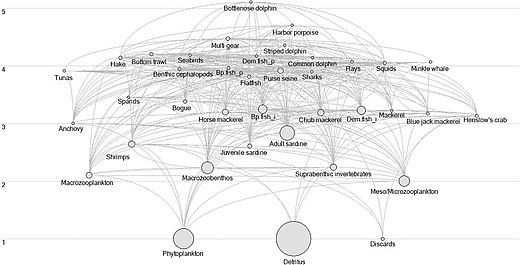
해양 생태계는 다양한 압력에 의해 영향을 받고, 결과적으로 정권 교체로 해석될 수 있는 중대한 변화를 겪을 수 있다.[225]전 세계의 해양 생태계는 자연적, 인공적으로 증가하는 압력의 영향을 받고 있으며, 결과적으로 전례 없는 속도로 상당한 변화를 겪는다.이러한 변화에 영향을 받아 생태계는 재편성할 수 있으며, 여전히 동일한 기능, 구조, 정체성을 유지할 수 있다.[226]그러나, 어떤 상황에서는, 생태계가 시스템의 구조와 기능을 수정하는 변화를 겪을 수도 있고, 이 과정은 새로운 정권으로의 전환으로 묘사될 수 있다.[226][227][228][225]
대개 정권 교체는 대규모 기후에 의한 변이,[229] 강도 높은 어업 착취 또는 둘 다에 의해 촉발된다.[231]정권 교체를 정의하기 위해 사용되는 기준은 다양하며, 시스템이 정권 교체를 거쳤음을 고려하기 위해 발생해야 하는 변화는 잘 정의되어 있지 않다.[232]일반적으로, 체제 이동은 다극성 수준(TLs)에서 관찰되는 종의 풍부함과 공동체 구성의 고진폭, 저주파 및 종종 갑작스러운 변화로 정의된다.[233]이러한 변화는 대규모 공간적 규모로 발생하며 기후 시스템의 물리적 변화와 동시에 발생할 것으로 예상된다.[233][228][234][235][236][237][232][225]
정권 교체는 북부 벤구엘라,[238] [239]북해, 발트해 등 여러 해양 생태계에서 설명되어 왔다.[240]대규모의 부유 생태계에서는, 종의 풍요와 그 대체물의 퇴폐적인 변동을 관찰하는 것이 일반적이다.[241]이러한 변동은 되돌릴 수 없을 수도 있고 북부 벤구엘라 생태계의 경우와 마찬가지로 새로운 정권의 지표가 될 수도 있다.[238]그러나 상향식 시스템의 변화는 체제변화의 지표가 아니라 생태계의 자연적 변동성의 한계 내에서 변동하는 것으로 해석될 수 있다.[234]포르투갈 대륙붕 생태계(PCSE)는 카나리아 전류 상승 시스템의 최북단을 구성하며, 지속적인 북풍으로 인해 봄과 여름에 발생하는 계절적 상승으로 특징지어진다.[242][243]근래에는 정어리, 꽁치, 말 고등어, 청잭 고등어, 멸치 등 연안 펠로릭 종들이 풍부하게 분포하면서 변화하고 있다.[244][245][246][247]게다가, 지난 수십 년 동안, 영양 수준이 높은 종의 증가가 기록되었다.[248]펠릭 커뮤니티의 근본적인 변화는 분명하지 않지만, 환경적 변동성, 종의 상호작용, 어업 압력 사이의 복잡한 상호 작용에서 비롯된다는 것이 제시되었다.[249][250][251][225]
지난 수십 년 동안 이베리아 해안 상승 강도(북풍을 강화하거나 약화시키는 결과로 발생함)의 변화가 일어났다는 증거가 있다.그러나, 이러한 변화의 특성은 일부 저자들이 상승할 수 있는 바람의 강화를 관찰한 반면 다른 저자들은 약화를 기록했다는 점에서 모순적이다.[254][255]포르투갈 해안을 따라 상승률과 강도에 대한 2019년 검토는 1950년대 이후 1970년대 중후반까지 그리고 1994년까지 남해안에서 지속된 상승률의 연속적인 약화를 기록했다.[256]1985~2009년 기간 동안 상승지수 증가는 연구된 모든 지역에서 문서화되었으며, 추가 상승 강도는 남부에서 관찰되었다.[256]10년 당 0.1 °C에서 0.2 °C에 이르는 수온의 지속적인 증가도 기록되었다.[257][225]
위협 및 거부
많은 해양동물들이 해안 서식지를 중요한 보육시설로 이용하고 있지만, 이러한 서식지들은 농업, 양식, 산업, 도시 확장에 의해 점점 더 위험해지고 있다.[258]실제로, 이러한 시스템은 산업화와 도시화의 증가, 생물학적, 물리적 자원(어류, 물, 에너지, 공간)의 손실 증가, 온난화 기후와 해수면 상승의 결과에 대한 복원력 감소라는 "삼중고"의 대상이 될 수 있다.[259]이로 인해 전 세계적으로 자연 해안 생태계가 완전히 상실, 개조 또는 단절되는 현상이 발생하였다.예를 들어, 호주의 전체 그레이트 배리어 리프 해안선(2,300km)의 거의 10%가 도시 기반 시설(예: 암석 방조제, 제트기, 마리나)으로 대체되어 민감한 해안 생태계의 대규모 손실과 단편화를 초래하고 있다.[260]전세계 해초들의 손실은 20세기 말까지 해초 면적의 약 7%에 달했다.[261]전 세계 맹그로브의 약 40%가 1950년대 이후 사라졌으며[262] 96년부터 2016년까지 20년 동안 세계 맹그로브 중 9,736km2 이상이 지속적으로 퇴화되었다.[263]해안지대의 농업이 요구될 때 소금기가 빠지고, 삼림 벌채는 해안지대가 도시 및 산업발전에 전용될 때 해안지대의 식물(망그로브 등)에 대한 위협이 증가하는데,[262] 이 두 가지 모두 청탄소 저장고의 저하와 온실가스 배출의 증가를 초래할 수 있다.[264]이러한 해안 생태계에 대한 누적된 압력과 영향은 고립되거나 독립적이지 않고 오히려 시너지 효과를 내는데, 피드백과 상호작용이 개개인의 효과를 합보다 더 크게 만든다.[265]생태계 복원 디케이드가 시작되기 전 해에는 지속적인 영향을 완화하기 위한 대응 개발을 방해하는 연안 생태계의 복잡성 감소를 억제하는 중대한 지식 부족이 있다. 이는 최악의 미래 기후에 대한 해안 시스템의 예상 손실에 대한 불확실성은 말할 것도 없다.시나리오를 [266]바꾸다
복원
유엔은 2021~2030년을 '유엔 생태계 복원 10년'으로 선포했다.이러한 행동요구는 퇴화된 생태계의 세계복원을 대대적으로 가속화하고, 기후난방 위기에 대처하고, 식량안보를 강화하며, 깨끗한 물을 제공하고, 지구상의 생물다양성을 보호하기 위한 필요성을 인식하는 데 목적이 있다.복구 규모가 핵심이 될 것이다.예를 들어 본 챌린지는 2030년까지 저하된 지상 생태계의 3억5000만 km를2 인도 크기 정도로 복원한다는 목표를 갖고 있다.그러나 사람들에게 인상적인 혜택을 제공하는 푸른 해안 생태계 복원을 위한 국제적인 지원은 지지부진했다.
오른쪽 도표는 수정 및 영향 받은 연안 생태계의 현황과 복구 10년 후의 예상 상태를 보여준다.[266]또한, 과거 복구 노력의 성공에 대한 불확실성, 변경된 시스템의 현재 상태, 기후 변동성, 현재 또는 지평선에서 이용할 수 있는 복구 조치 등이 보여진다.이것은 해안 시스템을 위한 생태계 복원 10년을 제공하는 것이 10년 이상의 시간이 걸릴 수 있는 일을 진행시키기 위한 수단으로 볼 필요가 있다는 것을 의미할 수 있다.[266]
2030년까지 글로벌 맹그로브 지역을 20% 늘리겠다는 목표로 글로벌 맹그로브 얼라이언스만이[267] 본 챌린지에 근접한다.[266]그러나 맹그로브 과학자들은 이 목표에 대해 의구심을 갖고 있으며, 이것이 비현실적이고 이 목표에 도달하려는 부적절한 관행을 유발할 수 있다고 우려한다.[268][266]
보존 및 연결
최근에는 생물다양성 특성의 분포와 풍요를 형성하는 생태적 과정을 고려하는 것으로, 보존 우선화의 유일한 또는 주된 초점으로서 서식지 대표성에서 벗어나 지각적 변화가 일어나고 있다.[269][270][271][272]해양생태계에서는 연결과정이 무엇보다 중요하며,[273] 서식지 패치의 연결을 유지하는 해양보호구역의 시스템을 설계하는 것은 오랫동안 보존계획의 목표로 여겨져 왔다.[269][274]산호초 어류 개체군의 구조화에 중요한 두 가지 형태의 연결성이 있는데,[275][276] 그것은 바로 펠러지 환경에서 유충의 살포와 바다 경관을 가로지르는 개인에 의한 정착 후 이동이다.[277]점점 더 많은 문헌이 보존 우선순위에서 애벌레 연결을 고려하는 접근방식을 설명했지만,[278][279][280] 비교적 덜 주의를 기울이는 것은 사후 정착 연결을[273][281][282] 고려하는 방법을 개발하고 적용하기 위한 방법이었다.
바다경관 연결성(동일한 서식지 유형의 패치들 사이의 연결성)은 일야행성 운동 중이나 그들의 인생사에서 다른 단계에서 둘 이상의 서식지를 사용하는 종에게 필수적이다.맹그로브, 해초, 그리고 석호 암초는 산호초에서 성인 개체군으로의 생물학적 이동을 만드는 상업적이고 생태학적으로 중요한 많은 어종들에게 양묘장을 제공한다.[283][284][285]이러한 후방 산림 서식지들은 종종 더 많은 성인 생물자원을 지원하는 산호초를 위해 보존이나 관리를 위해 간과되지만, 서식지 파괴와 손실의 위험이 더 크지는 않더라도 동등할 수 있다.[286][46][287]청소년이 어업인의 표적이 되지 않는 곳에서도, 예를 들어, 열악한 토지 이용 관행에 의한 침적 등으로 인해 서식지 파괴에 취약할 수 있다.[288][282]
산호초에는 유아 서식지에 근접하면 해양 보호구역의 실효성(즉, 어종의 풍부성, 밀도, 생물량의 증가)을 높일 수 있다는 명백한 경험적 증거가 있다.[131][289][290][291][292]예를 들어, 서태평양 전역의 연구 현장에서, 맹그로브에 가까운 보호 암초에서는 수확한 어종의 풍부함이 현저하게 컸지만, 맹그로브로부터 격리된 보호 암초에서는 그렇지 않았다.[291]존재론적 이동을 수행하는 초식성 어종의 기능적 역할도 맹그로브에 가까운 산호초의 복원력을 높일 수 있다.[293][294]이 증거고 광범위한 전화 연결에 대한 공간 management,[284][291][292]의 설계 안에 서식지 사이에서 설명하는 것에도 불구하고 어디seascape 연결을 명시적으로 공간 보존 우선 순위 결정(보존과 관리 행동에 대해 우선 순위 영역을 확인하기에 대한 분석적 프로세스)것으로 여겨진다. 몇몇 예들이 남아 있다..[282]
참고 항목
참조
- ^ a b c d e f g h i j Ehrnsten, 에바, 태양, Xiaole, Humborg, 크리스토프;Norkko, 알프;Savchuk, 올레크 P.;Slomp, 캐롤라인 P.,.Timmermann, 카렌, Gustafsson 보, G.(2020년).":카본, 인, Fluxes에 Benthic 1의 모델을 연결하는 것 환경의 변화가 온대 해안 바다에서 이해하는 것".해양 과학에 국경. 7.doi:10.3389/fmars.2020.00450.재료는 창조적 공용 귀인 4.0국제 라이센스 하에 가능하다 이 원본에서 복사되었다.
- ^ Tappin, A.D. (2002). "An Examination of the Fluxes of Nitrogen and Phosphorus in Temperate and Tropical Estuaries: Current Estimates and Uncertainties". Estuarine, Coastal and Shelf Science. 55 (6): 885–901. Bibcode:2002ECSS...55..885T. doi:10.1006/ecss.2002.1034.
- ^ Laruelle, G. G.; Roubeix, V.; Sferratore, A.; Brodherr, B.; Ciuffa, D.; Conley, D. J.; Dürr, H. H.; Garnier, J.; Lancelot, C.; Le Thi Phuong, Q.; Meunier, J.-D.; Meybeck, M.; Michalopoulos, P.; Moriceau, B.; Ní Longphuirt, S.; Loucaides, S.; Papush, L.; Presti, M.; Ragueneau, O.; Regnier, P.; Saccone, L.; Slomp, C. P.; Spiteri, C.; Van Cappellen, P. (2009). "Anthropogenic perturbations of the silicon cycle at the global scale: Key role of the land-ocean transition". Global Biogeochemical Cycles. 23 (4): n/a. Bibcode:2009GBioC..23.4031L. doi:10.1029/2008GB003267.
- ^ Regnier, Pierre; Friedlingstein, Pierre; Ciais, Philippe; MacKenzie, Fred T.; Gruber, Nicolas; Janssens, Ivan A.; Laruelle, Goulven G.; Lauerwald, Ronny; Luyssaert, Sebastiaan; Andersson, Andreas J.; Arndt, Sandra; Arnosti, Carol; Borges, Alberto V.; Dale, Andrew W.; Gallego-Sala, Angela; Goddéris, Yves; Goossens, Nicolas; Hartmann, Jens; Heinze, Christoph; Ilyina, Tatiana; Joos, Fortunat; Larowe, Douglas E.; Leifeld, Jens; Meysman, Filip J. R.; Munhoven, Guy; Raymond, Peter A.; Spahni, Renato; Suntharalingam, Parvadha; Thullner, Martin (2013). "Anthropogenic perturbation of the carbon fluxes from land to ocean". Nature Geoscience. 6 (8): 597–607. Bibcode:2013NatGe...6..597R. doi:10.1038/ngeo1830.
- ^ Ramesh, R.; Chen, Z.; Cummins, V.; Day, J.; d'Elia, C.; Dennison, B.; Forbes, D.L.; Glaeser, B.; Glaser, M.; Glavovic, B.; Kremer, H.; Lange, M.; Larsen, J.N.; Le Tissier, M.; Newton, A.; Pelling, M.; Purvaja, R.; Wolanski, E. (2015). "Land–Ocean Interactions in the Coastal Zone: Past, present & future". Anthropocene. 12: 85–98. doi:10.1016/j.ancene.2016.01.005.
- ^ Costanza, Robert; d'Arge, Ralph; De Groot, Rudolf; Farber, Stephen; Grasso, Monica; Hannon, Bruce; Limburg, Karin; Naeem, Shahid; O'Neill, Robert V.; Paruelo, Jose; Raskin, Robert G.; Sutton, Paul; Van Den Belt, Marjan (1997). "The value of the world's ecosystem services and natural capital". Nature. 387 (6630): 253–260. Bibcode:1997Natur.387..253C. doi:10.1038/387253a0. S2CID 672256.
- ^ Costanza, Robert; De Groot, Rudolf; Sutton, Paul; Van Der Ploeg, Sander; Anderson, Sharolyn J.; Kubiszewski, Ida; Farber, Stephen; Turner, R. Kerry (2014). "Changes in the global value of ecosystem services". Global Environmental Change. 26: 152–158. doi:10.1016/j.gloenvcha.2014.04.002.
- ^ Halpern, Benjamin S.; Walbridge, Shaun; Selkoe, Kimberly A.; Kappel, Carrie V.; Micheli, Fiorenza; d'Agrosa, Caterina; Bruno, John F.; Casey, Kenneth S.; Ebert, Colin; Fox, Helen E.; Fujita, Rod; Heinemann, Dennis; Lenihan, Hunter S.; Madin, Elizabeth M. P.; Perry, Matthew T.; Selig, Elizabeth R.; Spalding, Mark; Steneck, Robert; Watson, Reg (2008). "A Global Map of Human Impact on Marine Ecosystems". Science. 319 (5865): 948–952. Bibcode:2008Sci...319..948H. doi:10.1126/science.1149345. PMID 18276889. S2CID 26206024.
- ^ a b Cloern, James E.; Abreu, Paulo C.; Carstensen, Jacob; Chauvaud, Laurent; Elmgren, Ragnar; Grall, Jacques; Greening, Holly; Johansson, John Olov Roger; Kahru, Mati; Sherwood, Edward T.; Xu, Jie; Yin, Kedong (2016). "Human activities and climate variability drive fast-paced change across the world's estuarine-coastal ecosystems". Global Change Biology. 22 (2): 513–529. Bibcode:2016GCBio..22..513C. doi:10.1111/gcb.13059. PMID 26242490.
- ^ a b c d Lotze, Heike K.; Lenihan, Hunter S.; Bourque, Bruce J.; Bradbury, Roger H.; Cooke, Richard G.; Kay, Matthew C.; Kidwell, Susan M.; Kirby, Michael X.; Peterson, Charles H.; Jackson, Jeremy B. C. (2006). "Depletion, Degradation, and Recovery Potential of Estuaries and Coastal Seas". Science. 312 (5781): 1806–1809. Bibcode:2006Sci...312.1806L. doi:10.1126/science.1128035. PMID 16794081. S2CID 12703389.
- ^ Kemp, W. M.; Testa, J. M.; Conley, D. J.; Gilbert, D.; Hagy, J. D. (2009). "Temporal responses of coastal hypoxia to nutrient loading and physical controls". Biogeosciences. 6 (12): 2985–3008. Bibcode:2009BGeo....6.2985K. doi:10.5194/bg-6-2985-2009.
- ^ 유엔(2017년) 2017년 7월 6일 총회에서 채택된 결의안, 2030 지속가능발전 의제 관련 통계위원회 작업(A/RES/71/313)
- ^ Waltham, Nathan J.; Elliott, Michael; Lee, Shing Yip; Lovelock, Catherine; Duarte, Carlos M.; Buelow, Christina; Simenstad, Charles; Nagelkerken, Ivan; Claassens, Louw; Wen, Colin K-C; Barletta, Mario (2020). "UN Decade on Ecosystem Restoration 2021–2030—What Chance for Success in Restoring Coastal Ecosystems?". Frontiers in Marine Science. 7: 71. doi:10.3389/fmars.2020.00071. hdl:2440/123896. ISSN 2296-7745.
- ^ a b c d e US Department of Commerce, National Oceanic and Atmospheric Administration. "What is the intertidal zone?". oceanservice.noaa.gov. Retrieved 2019-03-21.
- ^ a b US Department of Commerce, National Oceanic and Atmospheric Administration. "What is an estuary?". oceanservice.noaa.gov. Retrieved 2019-03-22.
- ^ a b US Department of Commerce, National Oceanic and Atmospheric Administration. "Estuaries, NOS Education Offering". oceanservice.noaa.gov. Retrieved 2019-03-22.
- ^ "Estuaries". www.crd.bc.ca. 2013-11-14. Retrieved 2019-03-24.
- ^ US Department of Commerce, National Oceanic and Atmospheric Administration. "What is a lagoon?". oceanservice.noaa.gov. Retrieved 2019-03-24.
- ^ a b c d Miththapala, Sriyanie (2013). "Lagoons and Estuaries" (PDF). IUCN, International Union for Conservation of Nature.
- ^ "Corals and Coral Reefs". Ocean Portal Smithsonian. 2012-09-12. Retrieved 2018-03-27.
- ^ IPCC. 제3장: 해양과 비용 생태계와 그 서비스.IPCC 6차 평가 보고서. 2021년 10월 1일.https://report.ipcc.ch/ar6wg2/pdf/IPCC_AR6_WGII_FinalDraft_Chapter03.pdf.
- ^ Harman, Amanda (1997). Manatees & dugongs (in Lithuanian). New York: Benchmark Books. p. 7. ISBN 0-7614-0294-2. OCLC 34319364.
- ^ 예스바어트 T, 월레스 B, 하너 J, 핸콕 B.(2019) "생태계-엔지니어링 암초-빌딩 바이벌브에 의한 해비타트 개조 및 해안 보호"In: Smaal A, Ferreira J, Grant J, Petersen J, Strand ø. (eds) Marine Bivalves의 상품 및 서비스.스프링어. 도이:10.1007/978-3-19-96776-9_13
- ^ a b c d 펜들턴이요, 린우드. 미국, 도나토, 다니엘 C;Murray, 브라이언 C;크룩스, 스티븐, 젠킨스, W. 아론, Sifleet, 사만다, 공예, 크리스토퍼,Fourqurean, 제임스 W.;코프먼, J. 분;Marbà, Núria, Megonigal, 패트릭, 피전, 에밀리, HerrDorothee, 고든, 데이비드. Baldera, 알렉시스(2012년)."글로벌 평가"Blue Carbon"Vegetated 해안 Ecosystems의 전환과 몰락에서 방출되는".PLOS ONE.7(9):e43542.Bibcode:2012년PLoSO...743542P.doi:10.1371/journal.pone.0043542.PMC 3433453.PMID 22962585.재료는 창조적 공용 귀인 0.0국제 라이센스 하에 가능하다 이 원본에서 복사되었다.
- ^ a b Pendleton, Linwood; Donato, Daniel C.; Murray, Brian C.; Crooks, Stephen; Jenkins, W. Aaron; Sifleet, Samantha; Craft, Christopher; Fourqurean, James W.; Kauffman, J. Boone; Marbà, Núria; Megonigal, Patrick; Pidgeon, Emily; Herr, Dorothee; Gordon, David; Baldera, Alexis (2012). "Estimating Global "Blue Carbon" Emissions from Conversion and Degradation of Vegetated Coastal Ecosystems". PLOS ONE. 7 (9): e43542. Bibcode:2012PLoSO...743542P. doi:10.1371/journal.pone.0043542. PMC 3433453. PMID 22962585.
- ^ a b Kristensen, Erik; Bouillon, Steven; Dittmar, Thorsten; Marchand, Cyril (2008). "Organic carbon dynamics in mangrove ecosystems: A review". Aquatic Botany. 89 (2): 201–219. doi:10.1016/j.aquabot.2007.12.005.
- ^ Donato, Daniel C.; Kauffman, J. Boone; Murdiyarso, Daniel; Kurnianto, Sofyan; Stidham, Melanie; Kanninen, Markku (2011). "Mangroves among the most carbon-rich forests in the tropics". Nature Geoscience. 4 (5): 293–297. Bibcode:2011NatGe...4..293D. doi:10.1038/ngeo1123.
- ^ Donato, D.C.; Kauffman, J.B.; MacKenzie, R.A.; Ainsworth, A.; Pfleeger, A.Z. (2012). "Whole-island carbon stocks in the tropical Pacific: Implications for mangrove conservation and upland restoration". Journal of Environmental Management. 97: 89–96. doi:10.1016/j.jenvman.2011.12.004. PMID 22325586.
- ^ Eong, Ong Jin (1993). "Mangroves - a carbon source and sink". Chemosphere. 27 (6): 1097–1107. Bibcode:1993Chmsp..27.1097E. doi:10.1016/0045-6535(93)90070-L.
- ^ Granek, Elise; Ruttenberg, Benjamin I. (2008). "Changes in biotic and abiotic processes following mangrove clearing". Estuarine, Coastal and Shelf Science. 80 (4): 555–562. Bibcode:2008ECSS...80..555G. doi:10.1016/j.ecss.2008.09.012.
- ^ Sjöling, Sara; Mohammed, Salim M.; Lyimo, Thomas J.; Kyaruzi, Jasson J. (2005). "Benthic bacterial diversity and nutrient processes in mangroves: Impact of deforestation". Estuarine, Coastal and Shelf Science. 63 (3): 397–406. Bibcode:2005ECSS...63..397S. doi:10.1016/j.ecss.2004.12.002.
- ^ Strangmann, Antje; Bashan, Yoav; Giani, Luise (2008). "Methane in pristine and impaired mangrove soils and its possible effect on establishment of mangrove seedlings". Biology and Fertility of Soils. 44 (3): 511–519. doi:10.1007/s00374-007-0233-7. S2CID 18477012.
- ^ Sweetman, A. K.; Middelburg, J. J.; Berle, A. M.; Bernardino, A. F.; Schander, C.; Demopoulos, A. W. J.; Smith, C. R. (2010). "Impacts of exotic mangrove forests and mangrove deforestation on carbon remineralization and ecosystem functioning in marine sediments". Biogeosciences. 7 (7): 2129–2145. Bibcode:2010BGeo....7.2129S. doi:10.5194/bg-7-2129-2010.
- ^ Lovelock, Catherine E.; Ruess, Roger W.; Feller, Ilka C. (2011). "CO2 Efflux from Cleared Mangrove Peat". PLOS ONE. 6 (6): e21279. Bibcode:2011PLoSO...621279L. doi:10.1371/journal.pone.0021279. PMC 3126811. PMID 21738628.
- ^ a b Gaylard, 샘, Waycott, 미셸, Lavery, 폴(196월 2020년)."리뷰 연안과 해양 Ecosystems의 온대 호주에서 부 생태계 서비스의 논증 하시오".해양 과학에 국경.둔 미디어 SA.7.doi:10.3389/fmars.2020.00453.ISSN 2296-7745.재료는 창조적 공용 귀인 4.0국제 라이센스 하에 가능하다 이 원본에서 복사되었다.
- ^ d'Odorico, Paolo; He, Yufei; Collins, Scott; De Wekker, Stephan F. J.; Engel, Vic; Fuentes, Jose D. (2013). "Vegetation-microclimate feedbacks in woodland-grassland ecotones". Global Ecology and Biogeography. 22 (4): 364–379. doi:10.1111/geb.12000.
- ^ Lee, Jeom-Sook; Kim, Jong-Wook (2018). "Dynamics of zonal halophyte communities in salt marshes in the world". Journal of Marine and Island Cultures. 7. doi:10.21463/JMIC.2018.07.1.06. S2CID 133926655.
- ^ Cavanaugh, K. C.; Kellner, J. R.; Forde, A. J.; Gruner, D. S.; Parker, J. D.; Rodriguez, W.; Feller, I. C. (2014). "Poleward expansion of mangroves is a threshold response to decreased frequency of extreme cold events". Proceedings of the National Academy of Sciences. 111 (2): 723–727. Bibcode:2014PNAS..111..723C. doi:10.1073/pnas.1315800111. PMC 3896164. PMID 24379379.
- ^ Gedan, Keryn B.; Kirwan, Matthew L.; Wolanski, Eric; Barbier, Edward B.; Silliman, Brian R. (2011). "The present and future role of coastal wetland vegetation in protecting shorelines: Answering recent challenges to the paradigm". Climatic Change. 106 (1): 7–29. Bibcode:2011ClCh..106....7G. doi:10.1007/s10584-010-0003-7. S2CID 17867808.
- ^ Kadlec, Robert (2009). Treatment wetlands. Boca Raton, FL. ISBN 978-1-4200-1251-4. OCLC 311307374.
- ^ Yang, Q.; Tam, N.F.Y.; Wong, Y.S.; Luan, T.G.; Su, W.S.; Lan, C.Y.; Shin, P.K.S.; Cheung, S.G. (2008). "Potential use of mangroves as constructed wetland for municipal sewage treatment in Futian, Shenzhen, China". Marine Pollution Bulletin. 57 (6–12): 735–743. doi:10.1016/j.marpolbul.2008.01.037. PMID 18342338.
- ^ Ouyang, Xiaoguang; Guo, Fen (2016). "Paradigms of mangroves in treatment of anthropogenic wastewater pollution". Science of the Total Environment. 544: 971–979. Bibcode:2016ScTEn.544..971O. doi:10.1016/j.scitotenv.2015.12.013. PMID 26706768.
- ^ Gambrell, R. P. (1994). "Trace and Toxic Metals in Wetlands-A Review". Journal of Environmental Quality. 23 (5): 883–891. doi:10.2134/jeq1994.00472425002300050005x. PMID 34872228.
- ^ McLeod, Elizabeth; Chmura, Gail L.; Bouillon, Steven; Salm, Rodney; Björk, Mats; Duarte, Carlos M.; Lovelock, Catherine E.; Schlesinger, William H.; Silliman, Brian R. (2011). "A blueprint for blue carbon: Toward an improved understanding of the role of vegetated coastal habitats in sequestering CO 2". Frontiers in Ecology and the Environment. 9 (10): 552–560. doi:10.1890/110004.
- ^ Lipcius, Romuald N.; Seitz, Rochelle D.; Seebo, Michael S.; Colón-Carrión, Duamed (2005). "Density, abundance and survival of the blue crab in seagrass and unstructured salt marsh nurseries of Chesapeake Bay". Journal of Experimental Marine Biology and Ecology. 319 (1–2): 69–80. doi:10.1016/j.jembe.2004.12.034.
- ^ a b Mumby, Peter J. (2006). "Connectivity of reef fish between mangroves and coral reefs: Algorithms for the design of marine reserves at seascape scales". Biological Conservation. 128 (2): 215–222. doi:10.1016/j.biocon.2005.09.042.
- ^ Aburto-Oropeza, O.; Ezcurra, E.; Danemann, G.; Valdez, V.; Murray, J.; Sala, E. (2008). "Mangroves in the Gulf of California increase fishery yields". Proceedings of the National Academy of Sciences. 105 (30): 10456–10459. Bibcode:2008PNAS..10510456A. doi:10.1073/pnas.0804601105. PMC 2492483. PMID 18645185.
- ^ Nagelkerken, I.; Blaber, S.J.M.; Bouillon, S.; Green, P.; Haywood, M.; Kirton, L.G.; Meynecke, J.-O.; Pawlik, J.; Penrose, H.M.; Sasekumar, A.; Somerfield, P.J. (2008). "The habitat function of mangroves for terrestrial and marine fauna: A review". Aquatic Botany. 89 (2): 155–185. doi:10.1016/j.aquabot.2007.12.007.
- ^ Renzi, Julianna J.; He, Qiang; Silliman, Brian R. (2019). "Harnessing Positive Species Interactions to Enhance Coastal Wetland Restoration". Frontiers in Ecology and Evolution. 7. doi:10.3389/fevo.2019.00131.
 자료는 이 출처에서 복사되었으며, Creative Commons Accountation 4.0 International License에 따라 이용할 수 있다.
자료는 이 출처에서 복사되었으며, Creative Commons Accountation 4.0 International License에 따라 이용할 수 있다. - ^ a b US Department of Commerce, National Oceanic and Atmospheric Administration. "What is a mangrove forest?". oceanservice.noaa.gov. Retrieved 2019-03-21.
- ^ a b c "Mangroves". Smithsonian Ocean. Retrieved 2019-03-21.
- ^ a b c d "What is a Salt Marsh?" (PDF). New Hampshire Department of Environmental Services. 2004.
- ^ a b US Department of Commerce, National Oceanic and Atmospheric Administration. "What is a salt marsh?". oceanservice.noaa.gov. Retrieved 2019-03-20.
- ^ 만, K.H. 1973.해조류: 그들의 생산성과 성장을 위한 전략.과학 182: 975-981.
- ^ Graham, M.H., B.P. Kinlan, L.D. Drul, L.E. Garske, S.은행. 2007.열대 해양 다양성과 생산성의 잠재적 핫스팟으로서의 심해 다시마 리푸지아.국립과학아카데미 104: 16576-16580.
- ^ 크리스티, H, 요르겐센, N.M. 노더하우그, K.M. 와이지-닐슨, E. 2003.노르웨이 해안을 따라 다시마(Laminaria hyperborea)와 연관된 동물들의 종 분포 및 서식지 착취.영국 해양생물학회지 83, 687-699.
- ^ 잭슨, G.A., C.D.위넌트 1983.다시마 숲이 해안 조류에 미치는 영향대륙붕 보고서 2: 75-80
- ^ Steneck, R.S., M.H. Graham, B.J. Bourque, D.코벳, J.M. 얼랜드슨, J.A. 에스테스, M.J. 테그너.2002. 다시마 산림생태계: 생물다양성, 안정성, 복원력, 미래.환경보전 29: 436-459.
- ^ 살라, E, C.F. 부르두레스케, M.하르멜린비비엔1998. 어업, 영양의 폭포, 그리고 조류 조립의 구조: 오래되었지만 검증되지 않은 패러다임의 평가.오이코스 82: 425-439.
- ^ 데이튼, P.K. 1985a.다시마 공동체의 생태.연간 생태 및 체계적 검토 16: 215-245
- ^ 노더하우그, K.M. 크리스티, H. 2009.NE 대서양에서 성게 방목과 다시마 재배.해양생물연구 5,515-528
- ^ Morton, Adam; Cordell, Marni; Fanner, David; Ball, Andy; Evershed, Nick. "The dead sea: Tasmania's underwater forests disappearing in our lifetime". the Guardian. Retrieved 2020-10-22.
- ^ Steinbauer, James. "What Will It Take to Bring Back the Kelp Forest? - Bay Nature Magazine". Bay Nature. Retrieved 2020-10-22.
- ^ Harris, P.T.; Macmillan-Lawler, M.; Rupp, J.; Baker, E.K. (2014). "Geomorphology of the oceans". Marine Geology. 352: 4–24. Bibcode:2014MGeol.352....4H. doi:10.1016/j.margeo.2014.01.011.
- ^ a b X.L. Otero, De La Peena-Lastra, S, Pérez-Alberti, A, Ferreira, T.O., M.A. Huerta-Diaz(2018) "질소와 인의 순환에서 중요한 글로벌 동인으로서 새로운 식민지"자연 통신, 9(1): 1–8. doi:10.1038/s41467-017-02446-8.자료는 이 출처에서 복사되었으며, Creative Commons Accountation 4.0 International License에 따라 이용할 수 있다.
- ^ Barrett, Kyle; Anderson, Wendy B.; Wait, D. Alexander; Grismer, L. Lee; Polis†, Gary A.; Rose†, Michael D. (2005). "Marine subsidies alter the diet and abundance of insular and coastal lizard populations". Oikos. 109: 145–153. doi:10.1111/j.0030-1299.2005.13728.x.
- ^ Polis, Gary A.; Hurd, Stephen D. (1996). "Linking Marine and Terrestrial Food Webs: Allochthonous Input from the Ocean Supports High Secondary Productivity on Small Islands and Coastal Land Communities". The American Naturalist. 147 (3): 396–423. doi:10.1086/285858. S2CID 84701185.
- ^ Gende, Scott M.; Edwards, Richard T.; Willson, Mary F.; Wipfli, Mark S. (2002). "Pacific Salmon in Aquatic and Terrestrial Ecosystems". BioScience. 52 (10): 917. doi:10.1641/0006-3568(2002)052[0917:PSIAAT]2.0.CO;2. ISSN 0006-3568.
- ^ a b Gagnon, Karine; Rothäusler, Eva; Syrjänen, Anneli; Yli-Renko, Maria; Jormalainen, Veijo (2013). "Seabird Guano Fertilizes Baltic Sea Littoral Food Webs". PLOS ONE. 8 (4): e61284. Bibcode:2013PLoSO...861284G. doi:10.1371/journal.pone.0061284. PMC 3623859. PMID 23593452.
- ^ Mizota, Chitoshi; Noborio, Kosuke; Mori, Yoshiaki (2012). "The Great Cormorant (Phalacrocorax carbo) colony as a "hot spot" of nitrous oxide (N2O) emission in central Japan". Atmospheric Environment. 57: 29–34. Bibcode:2012AtmEn..57...29M. doi:10.1016/j.atmosenv.2012.02.007.
- ^ Bird, Michael I.; Tait, Elaine; Wurster, Christopher M.; Furness, Robert W. (2008). "Stable carbon and nitrogen isotope analysis of avian uric acid". Rapid Communications in Mass Spectrometry. 22 (21): 3393–3400. Bibcode:2008RCMS...22.3393B. doi:10.1002/rcm.3739. PMID 18837063.
- ^ a b Caut, Stéphane; Angulo, Elena; Pisanu, Benoit; Ruffino, Lise; Faulquier, Lucie; Lorvelec, Olivier; Chapuis, Jean-Louis; Pascal, Michel; Vidal, Eric; Courchamp, Franck (2012). "Seabird Modulations of Isotopic Nitrogen on Islands". PLOS ONE. 7 (6): e39125. Bibcode:2012PLoSO...739125C. doi:10.1371/journal.pone.0039125. PMC 3377609. PMID 22723945.
- ^ Mulder, Christa P. H.; Anderson, Wendy B.; Towns, David R.; Bellingham, Peter J. (8 September 2011). Seabird Islands: Ecology, Invasion, and Restoration. ISBN 9780199735693.
- ^ McFadden, Tyler Neal; Kauffman, J. Boone; Bhomia, Rupesh K. (2016). "Effects of nesting waterbirds on nutrient levels in mangroves, Gulf of Fonseca, Honduras". Wetlands Ecology and Management. 24 (2): 217–229. doi:10.1007/s11273-016-9480-4. S2CID 6021420.
- ^ Zwolicki, Adrian; Zmudczyńska-Skarbek, Katarzyna Małgorzata; Iliszko, Lech; Stempniewicz, Lech (2013). "Guano deposition and nutrient enrichment in the vicinity of planktivorous and piscivorous seabird colonies in Spitsbergen". Polar Biology. 36 (3): 363–372. doi:10.1007/s00300-012-1265-5. S2CID 12110520.
- ^ Doughty, Christopher E.; Roman, Joe; Faurby, Søren; Wolf, Adam; Haque, Alifa; Bakker, Elisabeth S.; Malhi, Yadvinder; Dunning, John B.; Svenning, Jens-Christian (2016). "Global nutrient transport in a world of giants". Proceedings of the National Academy of Sciences. 113 (4): 868–873. Bibcode:2016PNAS..113..868D. doi:10.1073/pnas.1502549112. PMC 4743783. PMID 26504209.
- ^ a b Honig, Susanna E.; Mahoney, Brenna (2016). "Evidence of seabird guano enrichment on a coral reef in Oahu, Hawaii". Marine Biology. 163 (2). doi:10.1007/s00227-015-2808-4. S2CID 87850538.
- ^ Kolb, GS; Ekholm, J.; Hambäck, PA (2010). "Effects of seabird nesting colonies on algae and aquatic invertebrates in coastal waters". Marine Ecology Progress Series. 417: 287–300. Bibcode:2010MEPS..417..287K. doi:10.3354/meps08791.
- ^ Wainright, S. C.; Haney, J. C.; Kerr, C.; Golovkin, A. N.; Flint, M. V. (1998). "Utilization of nitrogen derived from seabird guano by terrestrial and marine plants at St. Paul, Pribilof Islands, Bering Sea, Alaska". Marine Biology. 131: 63–71. doi:10.1007/s002270050297. S2CID 83734364.
- ^ Staunton Smith, J.; Johnson, CR (1995). "Nutrient inputs from seabirds and humans on a populated coral cay". Marine Ecology Progress Series. 124: 189–200. Bibcode:1995MEPS..124..189S. doi:10.3354/meps124189.
- ^ a b c 로랭, 앤, Houlbrèque, 패니, Benzoni, 프란체스카. Barjon, 루시,.Tremblay-Boyer, 로라, Menkes, 크리스토프;Gillikin, 데이비드 P.;Payri, 클로드, 주르당, 모랭, Boussarie, 제르맹, Verheyden, Anouk, 비달, 에릭(2017년)."reef-building 산호에 대한 원격 태평양 섬들에서 바다새는 공급 질소".과학 보고서. 7(1):3721.Bibcode:2017NatSR...7.3721L. doi:10.1038/s41598-017-03781-y. 1.5473863.PMID 28623288.S2CID 6539261.재료는 창조적 공용 귀인 4.0국제 라이센스 하에 가능하다 이 원본에서 복사되었다.
- ^ Connell, Des W. (4 May 2018). Pollution in Tropical Aquatic Systems. ISBN 9781351092777.
- ^ Hatcher, Bruce Gordon (1990). "Coral reef primary productivity. A hierarchy of pattern and process". Trends in Ecology & Evolution. 5 (5): 149–155. doi:10.1016/0169-5347(90)90221-X. PMID 21232343.
- ^ Falkowski, Paul G.; Dubinsky, Zvy; Muscatine, Leonard; McCloskey, Lawrence (1993). "Population Control in Symbiotic Corals". BioScience. 43 (9): 606–611. doi:10.2307/1312147. JSTOR 1312147.
- ^ a b Marubini, F.; Davies, P. S. (1996). "Nitrate increases zooxanthellae population density and reduces skeletogenesis in corals". Marine Biology. 127 (2): 319–328. doi:10.1007/BF00942117. S2CID 85085823.
- ^ 무스카틴, L. (1990) "탄소와 산호초에서 에너지 유동에서 공생 해조류의 역할," 에코시스템 월드, 25: 75–87.
- ^ Ferrier, M. Drew (1991). "Net uptake of dissolved free amino acids by four scleractinian corals". Coral Reefs. 10 (4): 183–187. Bibcode:1991CorRe..10..183F. doi:10.1007/BF00336772. S2CID 25973061.
- ^ Furla, P.; Allemand, D.; Shick, J. M.; Ferrier-Pagès, C.; Richier, S.; Plantivaux, A.; Merle, P. L.; Tambutté, S. (2005). "The Symbiotic Anthozoan: A Physiological Chimera between Alga and Animal". Integrative and Comparative Biology. 45 (4): 595–604. doi:10.1093/icb/45.4.595. PMID 21676806.
- ^ Mills, Matthew M.; Lipschultz, Fredric; Sebens, Kenneth P. (2004). "Particulate matter ingestion and associated nitrogen uptake by four species of scleractinian corals". Coral Reefs. 23 (3): 311–323. doi:10.1007/s00338-004-0380-3. S2CID 13212636.
- ^ Mills, M. M.; Sebens, K. P. (2004). "Ingestion and assimilation of nitrogen from benthic sediments by three species of coral". Marine Biology. 145 (6): 1097–1106. doi:10.1007/s00227-004-1398-3. S2CID 84698653.
- ^ Houlbrèque, F.; Tambutté, E.; Richard, C.; Ferrier-Pagès, C. (2004). "Importance of a micro-diet for scleractinian corals". Marine Ecology Progress Series. 282: 151–160. Bibcode:2004MEPS..282..151H. doi:10.3354/meps282151.
- ^ Ferrier-Pagès, C.; Witting, J.; Tambutté, E.; Sebens, K. P. (2003). "Effect of natural zooplankton feeding on the tissue and skeletal growth of the scleractinian coral Stylophora pistillata". Coral Reefs. 22 (3): 229–240. doi:10.1007/s00338-003-0312-7. S2CID 44869188.
- ^ Marubini, Francesca; Thake, Brenda (1999). "Bicarbonate addition promotes coral growth". Limnology and Oceanography. 44 (3): 716–720. Bibcode:1999LimOc..44..716M. doi:10.4319/lo.1999.44.3.0716.
- ^ Ferrier-Pagès, C.; Leclercq, N.; Jaubert, J.; Pelegrí, SP (2000). "Enhancement of pico- and nanoplankton growth by coral exudates". Aquatic Microbial Ecology. 21: 203–209. doi:10.3354/ame021203.
- ^ Renegar, DA; Riegl, BM (2005). "Effect of nutrient enrichment and elevated CO2 partial pressure on growth rate of Atlantic scleractinian coral Acropora cervicornis". Marine Ecology Progress Series. 293: 69–76. Bibcode:2005MEPS..293...69R. doi:10.3354/meps293069.
- ^ a b c d e f g 애투드, 트리샤 B;HammillEdd(2018년)."해양 Predators의 프로비저닝 생태계 서비스의 해안 플랜트 지역의 중요성".플랜트 과학에 국경.9:1289년. doi:10.3389/fpls.2018.01289.PMC6129962.PMID 30233626.재료는 창조적 공용 귀인 4.0국제 라이센스 하에 가능하다 이 원본에서 복사되었다.
- ^ Hairston, Nelson G.; Smith, Frederick E.; Slobodkin, Lawrence B. (1960). "Community Structure, Population Control, and Competition". The American Naturalist. University of Chicago Press. 94 (879): 421–425. doi:10.1086/282146. ISSN 0003-0147. S2CID 84548124.
- ^ a b c d Estes, James A.; Terborgh, John; Brashares, Justin S.; Power, Mary E.; Berger, Joel; Bond, William J.; Carpenter, Stephen R.; Essington, Timothy E.; Holt, Robert D.; Jackson, Jeremy B. C.; Marquis, Robert J.; Oksanen, Lauri; Oksanen, Tarja; Paine, Robert T.; Pikitch, Ellen K.; Ripple, William J.; Sandin, Stuart A.; Scheffer, Marten; Schoener, Thomas W.; Shurin, Jonathan B.; Sinclair, Anthony R. E.; Soulé, Michael E.; Virtanen, Risto; Wardle, David A. (2011). "Trophic Downgrading of Planet Earth". Science. 333 (6040): 301–306. Bibcode:2011Sci...333..301E. doi:10.1126/science.1205106. PMID 21764740. S2CID 7752940.
- ^ Zedler, Joy B.; Kercher, Suzanne (2005). "WETLAND RESOURCES: Status, Trends, Ecosystem Services, and Restorability". Annual Review of Environment and Resources. 30: 39–74. doi:10.1146/annurev.energy.30.050504.144248.
- ^ Waycott, M.; Duarte, C. M.; Carruthers, T. J. B.; Orth, R. J.; Dennison, W. C.; Olyarnik, S.; Calladine, A.; Fourqurean, J. W.; Heck, K. L.; Hughes, A. R.; Kendrick, G. A.; Kenworthy, W. J.; Short, F. T.; Williams, S. L. (2009). "Accelerating loss of seagrasses across the globe threatens coastal ecosystems". Proceedings of the National Academy of Sciences. 106 (30): 12377–12381. Bibcode:2009PNAS..10612377W. doi:10.1073/pnas.0905620106. PMC 2707273. PMID 19587236.
- ^ Duarte, Carlos M.; Losada, Iñigo J.; Hendriks, Iris E.; Mazarrasa, Inés; Marbà, Núria (2013). "The role of coastal plant communities for climate change mitigation and adaptation". Nature Climate Change. 3 (11): 961–968. Bibcode:2013NatCC...3..961D. doi:10.1038/nclimate1970.
- ^ Paleczny, Michelle; Hammill, Edd; Karpouzi, Vasiliki; Pauly, Daniel (2015). "Population Trend of the World's Monitored Seabirds, 1950-2010". PLOS ONE. 10 (6): e0129342. Bibcode:2015PLoSO..1029342P. doi:10.1371/journal.pone.0129342. PMC 4461279. PMID 26058068.
- ^ Jackson, J. B. C. (8 May 2001). "What was natural in the coastal oceans?". Proceedings of the National Academy of Sciences. 98 (10): 5411–5418. Bibcode:2001PNAS...98.5411J. doi:10.1073/pnas.091092898. ISSN 0027-8424. PMC 33227. PMID 11344287.
- ^ Jackson, Jeremy B. C.; Kirby, Michael X.; Berger, Wolfgang H.; Bjorndal, Karen A.; Botsford, Louis W.; Bourque, Bruce J.; Bradbury, Roger H.; Cooke, Richard; Erlandson, Jon; Estes, James A.; Hughes, Terence P.; Kidwell, Susan; Lange, Carina B.; Lenihan, Hunter S.; Pandolfi, John M.; Peterson, Charles H.; Steneck, Robert S.; Tegner, Mia J.; Warner, Robert R. (27 July 2001). "Historical Overfishing and the Recent Collapse of Coastal Ecosystems". Science. American Association for the Advancement of Science (AAAS). 293 (5530): 629–637. doi:10.1126/science.1059199. ISSN 0036-8075. PMID 11474098. S2CID 1459898.
- ^ a b McCauley, Douglas J.; Pinsky, Malin L.; Palumbi, Stephen R.; Estes, James A.; Joyce, Francis H.; Warner, Robert R. (2015). "Marine defaunation: Animal loss in the global ocean". Science. 347 (6219). doi:10.1126/science.1255641. PMID 25593191. S2CID 2500224.
- ^ Lotze, Heike K.; Worm, Boris (2009). "Historical baselines for large marine animals". Trends in Ecology & Evolution. 24 (5): 254–262. doi:10.1016/j.tree.2008.12.004. PMID 19251340.
- ^ Estes, James A.; Palmisano, John F. (1974). "Sea Otters: Their Role in Structuring Nearshore Communities". Science. 185 (4156): 1058–1060. Bibcode:1974Sci...185.1058E. doi:10.1126/science.185.4156.1058. PMID 17738247. S2CID 35892592.
- ^ Sala, E.; Zabala, M. (1996). "Fish predation and the structure of the sea urchin Paracentrotus lividus populations in the NW Mediterranean". Marine Ecology Progress Series. 140: 71–81. Bibcode:1996MEPS..140...71S. doi:10.3354/meps140071.
- ^ Myers, Ransom A.; Baum, Julia K.; Shepherd, Travis D.; Powers, Sean P.; Peterson, Charles H. (2007). "Cascading Effects of the Loss of Apex Predatory Sharks from a Coastal Ocean". Science. 315 (5820): 1846–1850. Bibcode:2007Sci...315.1846M. doi:10.1126/science.1138657. PMID 17395829. S2CID 22332630.
- ^ Heithaus, Michael R.; Alcoverro, Teresa; Arthur, Rohan; Burkholder, Derek A.; Coates, Kathryn A.; Christianen, Marjolijn J. A.; Kelkar, Nachiket; Manuel, Sarah A.; Wirsing, Aaron J.; Kenworthy, W. Judson; Fourqurean, James W. (2014). "Seagrasses in the age of sea turtle conservation and shark overfishing". Frontiers in Marine Science. 1. doi:10.3389/fmars.2014.00028.
- ^ Coverdale, Tyler C.; Brisson, Caitlin P.; Young, Eric W.; Yin, Stephanie F.; Donnelly, Jeffrey P.; Bertness, Mark D. (2014). "Indirect Human Impacts Reverse Centuries of Carbon Sequestration and Salt Marsh Accretion". PLOS ONE. 9 (3): e93296. Bibcode:2014PLoSO...993296C. doi:10.1371/journal.pone.0093296. PMC 3968132. PMID 24675669.
- ^ Wilmers, Christopher C.; Estes, James A.; Edwards, Matthew; Laidre, Kristin L.; Konar, Brenda (2012). "Do trophic cascades affect the storage and flux of atmospheric carbon? An analysis of sea otters and kelp forests". Frontiers in Ecology and the Environment. 10 (8): 409–415. doi:10.1890/110176.
- ^ a b Atwood, Trisha B.; Connolly, Rod M.; Ritchie, Euan G.; Lovelock, Catherine E.; Heithaus, Michael R.; Hays, Graeme C.; Fourqurean, James W.; MacReadie, Peter I. (2015). "Predators help protect carbon stocks in blue carbon ecosystems". Nature Climate Change. 5 (12): 1038–1045. Bibcode:2015NatCC...5.1038A. doi:10.1038/NCLIMATE2763.
- ^ Hughes, Brent B.; Hammerstrom, Kamille K.; Grant, Nora E.; Hoshijima, Umi; Eby, Ron; Wasson, Kerstin (11 May 2016). "Trophic cascades on the edge: fostering seagrass resilience via a novel pathway". Oecologia. Springer Science and Business Media LLC. 182 (1): 231–241. Bibcode:2016Oecol.182..231H. doi:10.1007/s00442-016-3652-z. ISSN 0029-8549. PMID 27167224. S2CID 15168162.
- ^ Silvestri, Silvia; Kershaw, Francine (2010). Framing the Flow: Innovative Approaches to Understand, Protect and Value Ecosystem Services Across Linked Habitats. ISBN 9789280730654.
- ^ a b c 피트, SJ,(알.(2021년)."Seascape 생태학:신흥 바다 지속 가능성 science"에 연구 우선 순위가 인식하는.해양 생태학 시리즈이다.663년:1–29.Bibcode:2021MEPS..663....1P.doi:10.3354/meps13661.ISSN 0171-8630.S2CID 233453217.재료는 창조적 공용 귀인 4.0국제 라이센스 하에 가능하다 이 원본에서 복사되었다.
- ^ Pittman, Simon (2018). Seascape ecology. Hoboken, NJ, USA: John Wiley & Sons, Inc. ISBN 978-1-119-08443-3. OCLC 993642256.
- ^ Steele, John H. (1978). "Some Comments on Plankton Patches". Spatial Pattern in Plankton Communities. pp. 1–20. doi:10.1007/978-1-4899-2195-6_1. ISBN 978-1-4899-2197-0.
- ^ Levin, Simon A. (1992). "The Problem of Pattern and Scale in Ecology: The Robert H. MacArthur Award Lecture". Ecology. 73 (6): 1943–1967. doi:10.2307/1941447. JSTOR 1941447.
- ^ a b Pittman, Simon (2018). Seascape ecology. Hoboken, NJ, USA: John Wiley & Sons, Inc. ISBN 978-1-119-08443-3. OCLC 993642256.
- ^ Thrush, S.F; Schneider, D.C; Legendre, P.; Whitlatch, R.B; Dayton, P.K; Hewitt, J.E; Hines, A.H; Cummings, V.J; Lawrie, S.M; Grant, J.; Pridmore, R.D; Turner, S.J; McArdle, B.H (1997). "Scaling-up from experiments to complex ecological systems: Where to next?". Journal of Experimental Marine Biology and Ecology. 216 (1–2): 243–254. doi:10.1016/S0022-0981(97)00099-3.
- ^ Schneider, David C. (2001). "The Rise of the Concept of Scale in Ecology". BioScience. 51 (7): 545. doi:10.1641/0006-3568(2001)051[0545:TROTCO]2.0.CO;2. ISSN 0006-3568.
- ^ a b Boström, C.; Pittman, SJ; Simenstad, C.; Kneib, RT (2011). "Seascape ecology of coastal biogenic habitats: Advances, gaps, and challenges". Marine Ecology Progress Series. 427: 191–217. Bibcode:2011MEPS..427..191B. doi:10.3354/meps09051.
- ^ Bishop, Melanie J.; Mayer-Pinto, Mariana; Airoldi, Laura; Firth, Louise B.; Morris, Rebecca L.; Loke, Lynette H.L.; Hawkins, Stephen J.; Naylor, Larissa A.; Coleman, Ross A.; Chee, Su Yin; Dafforn, Katherine A. (2017). "Effects of ocean sprawl on ecological connectivity: Impacts and solutions". Journal of Experimental Marine Biology and Ecology. 492: 7–30. doi:10.1016/j.jembe.2017.01.021.
- ^ Halpern, Benjamin S.; Frazier, Melanie; Afflerbach, Jamie; Lowndes, Julia S.; Micheli, Fiorenza; o'Hara, Casey; Scarborough, Courtney; Selkoe, Kimberly A. (2019). "Recent pace of change in human impact on the world's ocean". Scientific Reports. 9 (1): 11609. Bibcode:2019NatSR...911609H. doi:10.1038/s41598-019-47201-9. PMC 6691109. PMID 31406130.
- ^ Borja, Angel; Andersen, Jesper H.; Arvanitidis, Christos D.; Basset, Alberto; Buhl-Mortensen, Lene; Carvalho, Susana; Dafforn, Katherine A.; Devlin, Michelle J.; Escobar-Briones, Elva G.; Grenz, Christian; Harder, Tilmann; Katsanevakis, Stelios; Liu, Dongyan; Metaxas, Anna; Morán, Xosé Anxelu G.; Newton, Alice; Piroddi, Chiara; Pochon, Xavier; Queirós, Ana M.; Snelgrove, Paul V. R.; Solidoro, Cosimo; St. John, Michael A.; Teixeira, Heliana (2020). "Past and Future Grand Challenges in Marine Ecosystem Ecology". Frontiers in Marine Science. 7. doi:10.3389/fmars.2020.00362.
- ^ a b Claudet, Joachim; et al. (2020). "A Roadmap for Using the UN Decade of Ocean Science for Sustainable Development in Support of Science, Policy, and Action". One Earth. 2: 34–42. doi:10.1016/j.oneear.2019.10.012. S2CID 211352061.
- ^ d'Urban Jackson, Tim; Williams, Gareth J.; Walker-Springett, Guy; Davies, Andrew J. (2020). "Three-dimensional digital mapping of ecosystems: A new era in spatial ecology". Proceedings of the Royal Society B: Biological Sciences. 287 (1920). doi:10.1098/rspb.2019.2383. PMC 7031661. PMID 32075534.
- ^ García-Charton, J. A.; Pérez-Ruzafa, Á.; Sánchez-Jerez, P.; Bayle-Sempere, J. T.; Reñones, O.; Moreno, D. (2004). "Multi-scale spatial heterogeneity, habitat structure, and the effect of marine reserves on Western Mediterranean rocky reef fish assemblages". Marine Biology. 144: 161–182. doi:10.1007/s00227-003-1170-0. S2CID 85630092.
- ^ Huntington, Brittany E.; Karnauskas, Mandy; Babcock, Elizabeth A.; Lirman, Diego (2010). "Untangling Natural Seascape Variation from Marine Reserve Effects Using a Landscape Approach". PLOS ONE. 5 (8): e12327. Bibcode:2010PLoSO...512327H. doi:10.1371/journal.pone.0012327. PMC 2924891. PMID 20808833.
- ^ a b c Olds, Andrew D.; Connolly, Rod M.; Pitt, Kylie A.; Pittman, Simon J.; Maxwell, Paul S.; Huijbers, Chantal M.; Moore, Brad R.; Albert, Simon; Rissik, David; Babcock, Russell C.; Schlacher, Thomas A. (2016). "Quantifying the conservation value of seascape connectivity: A global synthesis". Global Ecology and Biogeography. 25: 3–15. doi:10.1111/geb.12388.
- ^ Proudfoot, Beatrice; Devillers, Rodolphe; Brown, Craig J. (2020). "Integrating fine‐scale seafloor mapping and spatial pattern metrics into marine conservation prioritization". Aquatic Conservation: Marine and Freshwater Ecosystems. 30 (8): 1613–1625. doi:10.1002/aqc.3360. S2CID 219767109.
- ^ Berkström, 샬롯, 파파도풀로스, 마이런;Jiddawi, Narriman 살레, Nordlund, 리나 Mtwana(2019년)."피셔스. 미국의 지역 생태학적 지식(LEK)연결과 해양 경관 관리에".해양 과학에 국경. 6.doi:10.3389/fmars.2019.00130.재료는 창조적 공용 귀인 4.0국제 라이센스 하에 가능하다 이 원본에서 복사되었다.
- ^ VonThenen, 미리암, Frederiksen, 피아, 한센, 헤닝 스텐 기관 단총, 실레, Kerstin S.(2020년)."A구조화된 지표 수영장 해양 공간을 계획하고expert-based 생태계 서비스 평가를 실천해야".오션 &, 해안 관리다. 187:105071.doi:10.1016/j.ocecoaman.2019.105071.S2CID 212792922.재료는 창조적 공용 귀인 4.0국제 라이센스 하에 가능하다 이 원본에서 복사되었다.
- ^ a b c d e 칼슨 RachelR., 에번스, 루크는 J., 푸, 샤나 A;그래디 브라이언트는 W, Li는 Jiwei, 실리, 메이건, 수, Yaping, Asner, 그레고리 P.(2021년)."이로써 짝짓land-sea 생태계의Synergistic 혜택".글로벌 생태 학부와 보존.엘제비어 BV.28:e01684.doi:10.1016/j.gecco.2021.e01684.ISSN 2351-9894.S2CID 236255580.재료는 창조적 공용 귀인 4.0국제 라이센스 하에 가능하다 이 원본에서 복사되었다.
- ^ a b c d e f g Ávila-Thieme, M.Isidora, 콜, 데릭, Pérez-Matus, 알레한드로, Wieters, 에비 A;나바 레테, 세르히오 a.;Marquet, 파블로 A;Valdovinos, 페르난다 S.(2021년)."연안 생산성과 영세 어업을 변경한 해양 먹이 그물에 영향을 미치기 상호 작용".과학 보고서. 11(1):1765년.Bibcode:2021NatSR..11.1765A. doi:10.1038/s41598-021-81392-4.PMC7815714.PMID 33469119.재료는 창조적 공용 귀인 4.0국제 라이센스 하에 가능하다 이 원본에서 복사되었다.
- ^ Somero, G. N. (2010). "The physiology of climate change: How potentials for acclimatization and genetic adaptation will determine 'winners' and 'losers'". Journal of Experimental Biology. 213 (6): 912–920. doi:10.1242/jeb.037473. PMID 20190116. S2CID 16838841.
- ^ Hoegh-Guldberg, Ove; Bruno, John F. (2010). "The Impact of Climate Change on the World's Marine Ecosystems". Science. 328 (5985): 1523–1528. Bibcode:2010Sci...328.1523H. doi:10.1126/science.1189930. PMID 20558709. S2CID 206526700.
- ^ Brose, Ulrich; Dunne, Jennifer A.; Montoya, Jose M.; Petchey, Owen L.; Schneider, Florian D.; Jacob, Ute (2012). "Climate change in size-structured ecosystems". Philosophical Transactions of the Royal Society B: Biological Sciences. 367 (1605): 2903–2912. doi:10.1098/rstb.2012.0232. PMC 3479741. PMID 23007078.
- ^ Doney, Scott C.; Ruckelshaus, Mary; Emmett Duffy, J.; Barry, James P.; Chan, Francis; English, Chad A.; Galindo, Heather M.; Grebmeier, Jacqueline M.; Hollowed, Anne B.; Knowlton, Nancy; Polovina, Jeffrey; Rabalais, Nancy N.; Sydeman, William J.; Talley, Lynne D. (2012). "Climate Change Impacts on Marine Ecosystems". Annual Review of Marine Science. 4: 11–37. Bibcode:2012ARMS....4...11D. doi:10.1146/annurev-marine-041911-111611. PMID 22457967.
- ^ a b Kwiatkowski, Lester; Aumont, Olivier; Bopp, Laurent (2019). "Consistent trophic amplification of marine biomass declines under climate change". Global Change Biology. 25 (1): 218–229. Bibcode:2019GCBio..25..218K. doi:10.1111/gcb.14468. PMID 30295401. S2CID 52930402.
- ^ Bakun, Andrew (1990). "Global Climate Change and Intensification of Coastal Ocean Upwelling". Science. 247 (4939): 198–201. Bibcode:1990Sci...247..198B. doi:10.1126/science.247.4939.198. PMID 17813287. S2CID 32516158.
- ^ Bakun, Andrew; Field, David B.; Redondo-Rodriguez, ANA; Weeks, Scarla J. (2010). "Greenhouse gas, upwelling-favorable winds, and the future of coastal ocean upwelling ecosystems". Global Change Biology. 16 (4): 1213–1228. Bibcode:2010GCBio..16.1213B. doi:10.1111/j.1365-2486.2009.02094.x.
- ^ 티엘, M, 카스티야, J.C., 페르난데스, M., Navarrete, S. (2007)"현재 칠레 북부와 중부의 훔볼트 시스템"해양학 및 해양 생물학:연간 검토, 45: 195-344
- ^ Morales, Carmen; Hormazabal, Samuel; Andrade, Isabel; Correa-Ramirez, Marco (2013). "Time-Space Variability of Chlorophyll-a and Associated Physical Variables within the Region off Central-Southern Chile". Remote Sensing. 5 (11): 5550–5571. Bibcode:2013RemS....5.5550M. doi:10.3390/rs5115550.
- ^ Aiken, C. M.; Navarrete, S. A.; Pelegrí, J. L. (2011). "Potential changes in larval dispersal and alongshore connectivity on the central Chilean coast due to an altered wind climate". Journal of Geophysical Research. 116 (G4). Bibcode:2011JGRG..116.4026A. doi:10.1029/2011JG001731.
- ^ a b Blanchard, Julia L.; Jennings, Simon; Holmes, Robert; Harle, James; Merino, Gorka; Allen, J. Icarus; Holt, Jason; Dulvy, Nicholas K.; Barange, Manuel (2012). "Potential consequences of climate change for primary production and fish production in large marine ecosystems". Philosophical Transactions of the Royal Society B: Biological Sciences. 367 (1605): 2979–2989. doi:10.1098/rstb.2012.0231. PMC 3479740. PMID 23007086.
- ^ Testa, Giovanni; Masotti, Italo; Farías, Laura (2018). "Temporal Variability in Net Primary Production in an Upwelling Area off Central Chile (36°S)". Frontiers in Marine Science. 5. doi:10.3389/fmars.2018.00179.
- ^ Batten, Sonia D.; Abu-Alhaija, Rana; Chiba, Sanae; Edwards, Martin; Graham, George; Jyothibabu, R.; Kitchener, John A.; Koubbi, Philippe; McQuatters-Gollop, Abigail; Muxagata, Erik; Ostle, Clare; Richardson, Anthony J.; Robinson, Karen V.; Takahashi, Kunio T.; Verheye, Hans M.; Wilson, Willie (2019). "A Global Plankton Diversity Monitoring Program". Frontiers in Marine Science. 6. doi:10.3389/fmars.2019.00321.
- ^ Chust, Guillem; Allen, J. Icarus; Bopp, Laurent; Schrum, Corinna; Holt, Jason; Tsiaras, Kostas; Zavatarelli, Marco; Chifflet, Marina; Cannaby, Heather; Dadou, Isabelle; Daewel, Ute; Wakelin, Sarah L.; Machu, Eric; Pushpadas, Dhanya; Butenschon, Momme; Artioli, Yuri; Petihakis, George; Smith, Chris; Garçon, Veronique; Goubanova, Katerina; Le Vu, Briac; Fach, Bettina A.; Salihoglu, Baris; Clementi, Emanuela; Irigoien, Xabier (2014). "Biomass changes and trophic amplification of plankton in a warmer ocean" (PDF). Global Change Biology. 20 (7): 2124–2139. Bibcode:2014GCBio..20.2124C. doi:10.1111/gcb.12562. hdl:11511/31726. PMID 24604761.
- ^ Weidberg, Nicolas; Ospina-Alvarez, Andres; Bonicelli, Jessica; Barahona, Mario; Aiken, Christopher M.; Broitman, Bernardo R.; Navarrete, Sergio A. (2020). "Spatial shifts in productivity of the coastal ocean over the past two decades induced by migration of the Pacific Anticyclone and Bakun's effect in the Humboldt Upwelling Ecosystem". Global and Planetary Change. 193: 103259. arXiv:2104.11698. Bibcode:2020GPC...19303259W. doi:10.1016/j.gloplacha.2020.103259. S2CID 224872806.
- ^ Aguirre, Catalina; García-Loyola, Sebastián; Testa, Giovanni; Silva, Diego; Farías, Laura (2018). "Insight into anthropogenic forcing on coastal upwelling off south-central Chile". Elementa: Science of the Anthropocene. 6. doi:10.1525/elementa.314.
- ^ Pascual, Mercedes (2006). Ecological networks : linking structure to dynamics in food webs. Oxford New York: Oxford University Press. ISBN 978-0-19-518816-5. OCLC 727944896.
- ^ a b c Dunne, Jennifer A.; Williams, Richard J.; Martinez, Neo D. (2002). "Network structure and biodiversity loss in food webs: Robustness increases with connectance". Ecology Letters. 5 (4): 558–567. doi:10.1046/j.1461-0248.2002.00354.x.
- ^ a b c Curtsdotter, Alva; Binzer, Amrei; Brose, Ulrich; De Castro, Francisco; Ebenman, Bo; Eklöf, Anna; Riede, Jens O.; Thierry, Aaron; Rall, Björn C. (2011). "Robustness to secondary extinctions: Comparing trait-based sequential deletions in static and dynamic food webs". Basic and Applied Ecology. 12 (7): 571–580. doi:10.1016/j.baae.2011.09.008.
- ^ a b Ramos-Jiliberto, Rodrigo; Valdovinos, Fernanda S.; Moisset De Espanés, Pablo; Flores, José D. (2012). "Topological plasticity increases robustness of mutualistic networks". Journal of Animal Ecology. 81 (4): 896–904. doi:10.1111/j.1365-2656.2012.01960.x. PMID 22313043.
- ^ a b Valdovinos, Fernanda S.; Moisset De Espanés, Pablo; Flores, José D.; Ramos-Jiliberto, Rodrigo (2013). "Adaptive foraging allows the maintenance of biodiversity of pollination networks". Oikos. 122 (6): 907–917. doi:10.1111/j.1600-0706.2012.20830.x.
- ^ a b Allesina, Stefano; Pascual, Mercedes (2009). "Googling Food Webs: Can an Eigenvector Measure Species' Importance for Coextinctions?". PLOS Computational Biology. 5 (9): e1000494. Bibcode:2009PLSCB...5E0494A. doi:10.1371/journal.pcbi.1000494. PMC 2725316. PMID 19730676.
- ^ De Santana, CN; Rozenfeld, AF; Marquet, PA; Duarte, CM (2013). "Topological properties of polar food webs". Marine Ecology Progress Series. 474: 15–26. Bibcode:2013MEPS..474...15D. doi:10.3354/meps10073. hdl:11336/7024.
- ^ Eklöf, Anna; Tang, Si; Allesina, Stefano (2013). "Secondary extinctions in food webs: A Bayesian network approach". Methods in Ecology and Evolution. 4 (8): 760–770. doi:10.1111/2041-210X.12062.
- ^ Staniczenko, Phillip P. A.; Lewis, Owen T.; Jones, Nick S.; Reed-Tsochas, Felix (2010). "Structural dynamics and robustness of food webs". Ecology Letters. 13 (7): 891–899. doi:10.1111/j.1461-0248.2010.01485.x. PMID 20482578.
- ^ Ives, Anthony R.; Cardinale, Bradley J. (2004). "Food-web interactions govern the resistance of communities after non-random extinctions". Nature. 429 (6988): 174–177. Bibcode:2004Natur.429..174I. doi:10.1038/nature02515. PMID 15141210. S2CID 4351240.
- ^ Rebolledo, Rolando; Navarrete, Sergio A.; Kéfi, Sonia; Rojas, Sergio; Marquet, Pablo A. (2019). "An Open-System Approach to Complex Biological Networks". SIAM Journal on Applied Mathematics. 79 (2): 619–640. doi:10.1137/17M1153431. S2CID 146077530.
- ^ McCann, Kevin Shear (2000). "The diversity–stability debate". Nature. 405 (6783): 228–233. doi:10.1038/35012234. PMID 10821283. S2CID 4319289.
- ^ Glaum, Paul; Cocco, Valentin; Valdovinos, Fernanda S. (2020). "Integrating economic dynamics into ecological networks: The case of fishery sustainability". Science Advances. 6 (45). Bibcode:2020SciA....6.4891G. doi:10.1126/sciadv.aaz4891. PMC 7673689. PMID 33148659.
- ^ Beusen, Arthur H. W.; Bouwman, Alexander F.; Van Beek, Ludovicus P. H.; Mogollón, José M.; Middelburg, Jack J. (2016). "Global riverine N and P transport to ocean increased during the 20th century despite increased retention along the aquatic continuum". Biogeosciences. 13 (8): 2441–2451. Bibcode:2016BGeo...13.2441B. doi:10.5194/bg-13-2441-2016.
- ^ Gustafsson, Bo G.; Schenk, Frederik; Blenckner, Thorsten; Eilola, Kari; Meier, H. E. Markus; Müller-Karulis, Bärbel; Neumann, Thomas; Ruoho-Airola, Tuija; Savchuk, Oleg P.; Zorita, Eduardo (2012). "Reconstructing the Development of Baltic Sea Eutrophication 1850–2006". Ambio. 41 (6): 534–548. doi:10.1007/s13280-012-0318-x. PMC 3428479. PMID 22926877.
- ^ Qu, Hong Juan; Kroeze, Carolien (4 August 2011). "Nutrient export by rivers to the coastal waters of China: management strategies and future trends". Regional Environmental Change. Springer Science and Business Media LLC. 12 (1): 153–167. doi:10.1007/s10113-011-0248-3. ISSN 1436-3798. S2CID 55439201.
- ^ Cui, S.; Shi, Y.; Groffman, P. M.; Schlesinger, W. H.; Zhu, Y.-G. (2013). "Centennial-scale analysis of the creation and fate of reactive nitrogen in China (1910-2010)". Proceedings of the National Academy of Sciences. 110 (6): 2052–2057. Bibcode:2013PNAS..110.2052C. doi:10.1073/pnas.1221638110. PMC 3568337. PMID 23341613.
- ^ Falkowski, P.; Scholes, R. J.; Boyle, E.; Canadell, J.; Canfield, D.; Elser, J.; Gruber, N.; Hibbard, K.; Högberg, P.; Linder, S.; MacKenzie, F. T.; Moore Iii, B.; Pedersen, T.; Rosenthal, Y.; Seitzinger, S.; Smetacek, V.; Steffen, W. (2000). "The Global Carbon Cycle: A Test of Our Knowledge of Earth as a System". Science. 290 (5490): 291–296. Bibcode:2000Sci...290..291F. doi:10.1126/science.290.5490.291. PMID 11030643.
- ^ Gruber, Nicolas; Galloway, James N. (2008). "An Earth-system perspective of the global nitrogen cycle". Nature. 451 (7176): 293–296. Bibcode:2008Natur.451..293G. doi:10.1038/nature06592. PMID 18202647. S2CID 4318396.
- ^ Statham, Peter J. (2012). "Nutrients in estuaries — an overview and the potential impacts of climate change". Science of the Total Environment. 434: 213–227. Bibcode:2012ScTEn.434..213S. doi:10.1016/j.scitotenv.2011.09.088. PMID 22119025.
- ^ Cloern, JE (2001). "Our evolving conceptual model of the coastal eutrophication problem". Marine Ecology Progress Series. 210: 223–253. Bibcode:2001MEPS..210..223C. doi:10.3354/meps210223.
- ^ Grall, Jacques; Chauvaud, Laurent (2002). "Marine eutrophication and benthos: The need for new approaches and concepts". Global Change Biology. 8 (9): 813–830. Bibcode:2002GCBio...8..813G. doi:10.1046/j.1365-2486.2002.00519.x.
- ^ Diaz, Robert J.; Rosenberg, Rutger (2008). "Spreading Dead Zones and Consequences for Marine Ecosystems". Science. 321 (5891): 926–929. Bibcode:2008Sci...321..926D. doi:10.1126/science.1156401. PMID 18703733. S2CID 32818786.
- ^ Breitburg, Denise; Levin, Lisa A.; Oschlies, Andreas; Grégoire, Marilaure; Chavez, Francisco P.; Conley, Daniel J.; Garçon, Véronique; Gilbert, Denis; Gutiérrez, Dimitri; Isensee, Kirsten; Jacinto, Gil S.; Limburg, Karin E.; Montes, Ivonne; Naqvi, S. W. A.; Pitcher, Grant C.; Rabalais, Nancy N.; Roman, Michael R.; Rose, Kenneth A.; Seibel, Brad A.; Telszewski, Maciej; Yasuhara, Moriaki; Zhang, Jing (2018). "Declining oxygen in the global ocean and coastal waters". Science. 359 (6371). Bibcode:2018Sci...359M7240B. doi:10.1126/science.aam7240. PMID 29301986. S2CID 206657115.
- ^ Griffiths, Jennifer R.; Kadin, Martina; Nascimento, Francisco J. A.; Tamelander, Tobias; Törnroos, Anna; Bonaglia, Stefano; Bonsdorff, Erik; Brüchert, Volker; Gårdmark, Anna; Järnström, Marie; Kotta, Jonne; Lindegren, Martin; Nordström, Marie C.; Norkko, Alf; Olsson, Jens; Weigel, Benjamin; Žydelis, Ramunas; Blenckner, Thorsten; Niiranen, Susa; Winder, Monika (2017). "The importance of benthic-pelagic coupling for marine ecosystem functioning in a changing world". Global Change Biology. 23 (6): 2179–2196. Bibcode:2017GCBio..23.2179G. doi:10.1111/gcb.13642. PMID 28132408. S2CID 13874905.
- ^ Cederwall, H., Elmgren, R. (1980) "Biomass의 biomass 증가는 발트해의 우량화를 보여준다."인: 발트해 해양 생물학자들의 심포지엄: 펠릭스와 벤트닉 생물학의 관계와 교류.
- ^ Pearson, T. H. 그리고 R. (1987년) 로젠버그."기근과 기근:해양 벤트릭 커뮤니티의 유혹적인 요소"라고 말했다. 커뮤니티 조직:제27회 영국생태학회 심포지엄, Aberystwyth 1986, Eds: P. S. Giller와 J. H. R. Gee (Oxford: Blackwell), 373–395.
- ^ a b Josefson, A.B.; Rasmussen, B. (2000). "Nutrient Retention by Benthic Macrofaunal Biomass of Danish Estuaries: Importance of Nutrient Load and Residence Time". Estuarine, Coastal and Shelf Science. 50 (2): 205–216. Bibcode:2000ECSS...50..205J. doi:10.1006/ecss.1999.0562.
- ^ Kautsky, N.; Evans, S. (1987). "Role of biodeposition by Mytilus edulis in the circulation of matter and nutrients in a Baltic coastal ecosystem". Marine Ecology Progress Series. 38: 201–212. Bibcode:1987MEPS...38..201K. doi:10.3354/meps038201.
- ^ 뉴웰 R.I. (2004) "정지 급유 쌍생 연체 동물들의 자연 및 재배 모집단의 생태계에 영향: 검토"조개류 연구 저널, 23(1) : 51–62.
- ^ Herman, P.M.J.; Middelburg, J.J.; Van De Koppel, J.; Heip, C.H.R. (1999). "Ecology of Estuarine Macrobenthos". Estuaries. Advances in Ecological Research. Vol. 29. pp. 195–240. doi:10.1016/S0065-2504(08)60194-4. ISBN 9780120139293.
- ^ Ehrnsten, Eva; Norkko, Alf; Timmermann, Karen; Gustafsson, Bo G. (2019). "Benthic-pelagic coupling in coastal seas – Modelling macrofaunal biomass and carbon processing in response to organic matter supply". Journal of Marine Systems. 196: 36–47. Bibcode:2019JMS...196...36E. doi:10.1016/j.jmarsys.2019.04.003. S2CID 155821874.
- ^ Kristensen, E.; Penha-Lopes, G.; Delefosse, M.; Valdemarsen, T.; Quintana, CO; Banta, GT (2012). "What is bioturbation? The need for a precise definition for fauna in aquatic sciences". Marine Ecology Progress Series. 446: 285–302. Bibcode:2012MEPS..446..285K. doi:10.3354/meps09506.
- ^ Villnäs, Anna; Norkko, Joanna; Hietanen, Susanna; Josefson, Alf B.; Lukkari, Kaarina; Norkko, Alf (2013). "The role of recurrent disturbances for ecosystem multifunctionality". Ecology. 94 (10): 2275–2287. doi:10.1890/12-1716.1. hdl:10138/233616. PMID 24358713.
- ^ Le Hir, P.; Monbet, Y.; Orvain, F. (2007). "Sediment erodability in sediment transport modelling: Can we account for biota effects?". Continental Shelf Research. 27 (8): 1116–1142. Bibcode:2007CSR....27.1116L. doi:10.1016/j.csr.2005.11.016.
- ^ Stief, P. (2013). "Stimulation of microbial nitrogen cycling in aquatic ecosystems by benthic macrofauna: Mechanisms and environmental implications". Biogeosciences. 10 (12): 7829–7846. Bibcode:2013BGeo...10.7829S. doi:10.5194/bg-10-7829-2013.
- ^ Aller, Robert C. (1982). "Carbonate Dissolution in Nearshore Terrigenous Muds: The Role of Physical and Biological Reworking". The Journal of Geology. University of Chicago Press. 90 (1): 79–95. Bibcode:1982JG.....90...79A. doi:10.1086/628652. ISSN 0022-1376. S2CID 129291436.
- ^ Barnosky, Anthony D.; Matzke, Nicholas; Tomiya, Susumu; Wogan, Guinevere O. U.; Swartz, Brian; Quental, Tiago B.; Marshall, Charles; McGuire, Jenny L.; Lindsey, Emily L.; Maguire, Kaitlin C.; Mersey, Ben; Ferrer, Elizabeth A. (2011). "Has the Earth's sixth mass extinction already arrived?". Nature. 471 (7336): 51–57. Bibcode:2011Natur.471...51B. doi:10.1038/nature09678. PMID 21368823. S2CID 4424650.
- ^ Chapin Iii, F. Stuart; Zavaleta, Erika S.; Eviner, Valerie T.; Naylor, Rosamond L.; Vitousek, Peter M.; Reynolds, Heather L.; Hooper, David U.; Lavorel, Sandra; Sala, Osvaldo E.; Hobbie, Sarah E.; Mack, Michelle C.; Díaz, Sandra (2000). "Consequences of changing biodiversity". Nature. 405 (6783): 234–242. doi:10.1038/35012241. PMID 10821284. S2CID 205006508.
- ^ Díaz, Sandra; Fargione, Joseph; Chapin, F. Stuart; Tilman, David (2006). "Biodiversity Loss Threatens Human Well-Being". PLOS Biology. 4 (8): e277. doi:10.1371/journal.pbio.0040277. PMC 1543691. PMID 16895442.
- ^ Worm, Boris; Hilborn, Ray; Baum, Julia K.; Branch, Trevor A.; Collie, Jeremy S.; Costello, Christopher; Fogarty, Michael J.; Fulton, Elizabeth A.; Hutchings, Jeffrey A.; Jennings, Simon; Jensen, Olaf P.; Lotze, Heike K.; Mace, Pamela M.; McClanahan, Tim R.; Minto, Cóilín; Palumbi, Stephen R.; Parma, Ana M.; Ricard, Daniel; Rosenberg, Andrew A.; Watson, Reg; Zeller, Dirk (2009). "Rebuilding Global Fisheries". Science. 325 (5940): 578–585. Bibcode:2009Sci...325..578W. doi:10.1126/science.1173146. PMID 19644114. S2CID 2805799.
- ^ Defeo, Omar; Castilla, Juan Carlos (2005). "More than One Bag for the World Fishery Crisis and Keys for Co-management Successes in Selected Artisanal Latin American Shellfisheries". Reviews in Fish Biology and Fisheries. 15 (3): 265–283. doi:10.1007/s11160-005-4865-0. S2CID 6912211.
- ^ Pauly, Daniel; Zeller, Dirk (2016). "Catch reconstructions reveal that global marine fisheries catches are higher than reported and declining". Nature Communications. 7: 10244. Bibcode:2016NatCo...710244P. doi:10.1038/ncomms10244. PMC 4735634. PMID 26784963.
- ^ Defeo, Omar; Castrejón, Mauricio; Pérez-Castañeda, Roberto; Castilla, Juan C.; Gutiérrez, Nicolás L.; Essington, Timothy E.; Folke, Carl (2016). "Co-management in Latin American small-scale shellfisheries: Assessment from long-term case studies". Fish and Fisheries. 17: 176–192. doi:10.1111/faf.12101.
- ^ 지속 가능한 어업: 어업에 대한 영토 사용권 프로그램 어업 해결 센터, 환경 보호 기금.회수: 2021년 11월 2일
- ^ 크리스티, F.T.(1982) "해양수산물의 법리적 사용권: 정의와 조건", 식품농업기구, 어업기술서 227.국제 연합, 로마.
- ^ a b Gelcich, S.; Hughes, T. P.; Olsson, P.; Folke, C.; Defeo, O.; Fernandez, M.; Foale, S.; Gunderson, L. H.; Rodriguez-Sickert, C.; Scheffer, M.; Steneck, R. S.; Castilla, J. C. (2010). "Navigating transformations in governance of Chilean marine coastal resources". Proceedings of the National Academy of Sciences. 107 (39): 16794–16799. doi:10.1073/pnas.1012021107. PMC 2947917. PMID 20837530.
- ^ Gelcich, S.; Cinner, J.; Donlan, CJ; Tapia-Lewin, S.; Godoy, N.; Castilla, JC (2017). "Fishers' perceptions on the Chilean coastal TURF system after two decades: Problems, benefits, and emerging needs". Bulletin of Marine Science. 93: 53–67. doi:10.5343/bms.2015.1082.
- ^ a b Castilla, Juan Carlos; Gelcich, Stefan; Defeo, Omar (2007). "Successes, Lessons, and Projections from Experience in Marine Benthic Invertebrate Artisanal Fisheries in Chile". Fisheries Management. pp. 23–42. doi:10.1002/9780470996072.ch2. ISBN 9780470996072.
- ^ Kéfi, Sonia; Berlow, Eric L.; Wieters, Evie A.; Joppa, Lucas N.; Wood, Spencer A.; Brose, Ulrich; Navarrete, Sergio A. (2015). "Network structure beyond food webs: Mapping non‐trophic and trophic interactions on Chilean rocky shores". Ecology. 96 (1): 291–303. doi:10.1890/13-1424.1. PMID 26236914.
- ^ a b Pérez-Matus, A.; Ospina-Alvarez, A.; Camus, PA; Carrasco, SA; Fernandez, M.; Gelcich, S.; Godoy, N.; Ojeda, FP; Pardo, LM; Rozbaczylo, N.; Subida, MD; Thiel, M.; Wieters, EA; Navarrete, SA (2017). "Temperate rocky subtidal reef community reveals human impacts across the entire food web". Marine Ecology Progress Series. 567: 1–16. Bibcode:2017MEPS..567....1P. doi:10.3354/meps12057.
- ^ Pérez-Matus, Alejandro; Carrasco, Sergio A.; Gelcich, Stefan; Fernandez, Miriam; Wieters, Evie A. (2017). "Exploring the effects of fishing pressure and upwelling intensity over subtidal kelp forest communities in Central Chile". Ecosphere. 8 (5): e01808. doi:10.1002/ecs2.1808.
- ^ Gelcich, Stefan; Fernández, Miriam; Godoy, Natalio; Canepa, Antonio; Prado, Luis; Castilla, Juan Carlos (2012). "Territorial User Rights for Fisheries as Ancillary Instruments for Marine Coastal Conservation in Chile". Conservation Biology. 26 (6): 1005–1015. doi:10.1111/j.1523-1739.2012.01928.x. PMID 22971114.
- ^ Oyanedel, Rodrigo; Keim, Andres; Castilla, Juan Carlos; Gelcich, Stefan (2018). "Illegal fishing and territorial user rights in Chile". Conservation Biology. 32 (3): 619–627. doi:10.1111/cobi.13048. PMID 29114934. S2CID 3703022.
- ^ Donlan, C. Josh; Wilcox, Chris; Luque, Gloria M.; Gelcich, Stefan (2020). "Estimating illegal fishing from enforcement officers". Scientific Reports. 10 (1): 12478. Bibcode:2020NatSR..1012478D. doi:10.1038/s41598-020-69311-5. PMC 7385102. PMID 32719385.
- ^ Andreu-Cazenave, Miguel; Subida, Maria Dulce; Fernandez, Miriam (2017). "Exploitation rates of two benthic resources across management regimes in central Chile: Evidence of illegal fishing in artisanal fisheries operating in open access areas". PLOS ONE. 12 (6): e0180012. Bibcode:2017PLoSO..1280012A. doi:10.1371/journal.pone.0180012. PMC 5493345. PMID 28666013.
- ^ Castilla, Juan Carlos (1999). "Coastal marine communities: Trends and perspectives from human-exclusion experiments". Trends in Ecology & Evolution. 14 (7): 280–283. doi:10.1016/s0169-5347(99)01602-x. PMID 10370266.
- ^ a b c d e f 엘 Mahrad, 바드르, 뉴튼, 앨리스, Icely, 존은 Kacimi, Ilias, Abalansa, 사무엘, Snoussi, 마리아(2020년)."원격 탐사 기술의 전인적 해안과 해양 환경 관리 프레임워크에 기여 분석:리뷰".원격 탐사. 12(14):2313.Bibcode:2020RemS...12.2313E. doi:10.3390/rs12142313.재료는 창조적 공용 귀인 4.0국제 라이센스 하에 가능하다 이 원본에서 복사되었다.
- ^ a b c d e f g Mariani, Patrizio, Bachmayer, 랄프. Kosta, Sokol, Pietrosemoli, Ermanno, Ardelan, 뮈라. Joachim.V. 코넬리, 더글러스 P.,.Delory, 에릭, 펄만과, JayS.;Petihakis, 조지,.톰슨, 플레처, Crise, 알레산드로(208월 2021년)."협업 자동화 및 IoT 기술 해안 오션 관찰 시스템".해양 과학에 국경.둔 미디어 SA.8.doi:10.3389/fmars.2021.647368.ISSN 2296-7745.재료는 창조적 공용 귀인 4.0국제 라이센스 하에 가능하다 이 원본에서 복사되었다.
- ^ 소규모의 크리스토퍼와 니콜스, 로버트 J.(2003) "해안지역의 인간 정착에 대한 세계적인 분석"[논문초록] 해안연구 19(3): 584-599
- ^ 발크, D, 몽고메리, M.R., 맥그란한, G, 킴, D, 마라, V, 토드, M, 부에트너, T., 도렐리엔, A. (2009) "도시 정착과 아프리카, 아시아, 남아메리카의 기후변화의 위험성 매핑"인구 역학 및 기후 변화, 80: 103.
- ^ He, Qiang; Bertness, Mark D.; Bruno, John F.; Li, Bo; Chen, Guoqian; Coverdale, Tyler C.; Altieri, Andrew H.; Bai, Junhong; Sun, Tao; Pennings, Steven C.; Liu, Jianguo; Ehrlich, Paul R.; Cui, Baoshan (2015). "Economic development and coastal ecosystem change in China". Scientific Reports. 4: 5995. doi:10.1038/srep05995. PMC 4125988. PMID 25104138.
- ^ El Mahrad, Badr; Abalansa, Samuel; Newton, Alice; Icely, John D.; Snoussi, Maria; Kacimi, Ilias (2020). "Social-Environmental Analysis for the Management of Coastal Lagoons in North Africa". Frontiers in Environmental Science. 8. doi:10.3389/fenvs.2020.00037.
- ^ Corvalán, C (2005). Ecosystems and human well-being : health synthesis : a report of the millennium ecosystem assessment. Geneva: World Health Organization. ISBN 978-92-4-156309-3. OCLC 560102324.
- ^ Kennedy, Robert E.; Townsend, Philip A.; Gross, John E.; Cohen, Warren B.; Bolstad, Paul; Wang, Y.Q.; Adams, Phyllis (2009). "Remote sensing change detection tools for natural resource managers: Understanding concepts and tradeoffs in the design of landscape monitoring projects". Remote Sensing of Environment. 113 (7): 1382–1396. Bibcode:2009RSEnv.113.1382K. doi:10.1016/j.rse.2008.07.018.
- ^ Strong, James Asa; Elliott, Michael (2017). "The value of remote sensing techniques in supporting effective extrapolation across multiple marine spatial scales". Marine Pollution Bulletin. 116 (1–2): 405–419. doi:10.1016/j.marpolbul.2017.01.028. PMID 28118970.
- ^ Cristina, Sónia; Icely, John; Costa Goela, Priscila; Angel Delvalls, Tomás; Newton, Alice (2015). "Using remote sensing as a support to the implementation of the European Marine Strategy Framework Directive in SW Portugal". Continental Shelf Research. 108: 169–177. Bibcode:2015CSR...108..169C. doi:10.1016/j.csr.2015.03.011.
- ^ Hart, Jane K.; Martinez, Kirk (1 May 2015). "Toward an environmental Internet of Things". Earth & Space Science. 2 (5): 194–200. Bibcode:2015E&SS....2..194H. doi:10.1002/2014EA000044.
- ^ Lynch, Tim P.; Morello, Elisabetta B.; Evans, Karen; Richardson, Anthony J.; Rochester, Wayne; Steinberg, Craig R.; Roughan, Moninya; Thompson, Peter; Middleton, John F.; Feng, Ming; Sherrington, Robert; Brando, Vittorio; Tilbrook, Bronte; Ridgway, Ken; Allen, Simon; Doherty, Peter; Hill, Katherine; Moltmann, Tim C. (17 December 2014). Álvarez, Inés (ed.). "IMOS National Reference Stations: A Continental-Wide Physical, Chemical and Biological Coastal Observing System". PLOS ONE. Public Library of Science (PLoS). 9 (12): e113652. Bibcode:2014PLoSO...9k3652L. doi:10.1371/journal.pone.0113652. ISSN 1932-6203. PMC 4269483. PMID 25517905.
- ^ Moltmann, Tim; Turton, Jon; Zhang, Huai-Min; Nolan, Glenn; Gouldman, Carl; Griesbauer, Laura; Willis, Zdenka; Piniella, Ángel Muñiz; Barrell, Sue; Andersson, Erik; Gallage, Champika; Charpentier, Etienne; Belbeoch, Mathieu; Poli, Paul; Rea, Anthony; Burger, Eugene F.; Legler, David M.; Lumpkin, Rick; Meinig, Christian; O’Brien, Kevin; Saha, Korak; Sutton, Adrienne; Zhang, Dongxiao; Zhang, Yongsheng (28 June 2019). "A Global Ocean Observing System (GOOS), Delivered Through Enhanced Collaboration Across Regions, Communities, and New Technologies". Frontiers in Marine Science. Frontiers Media SA. 6. doi:10.3389/fmars.2019.00291. ISSN 2296-7745.
- ^ Farcy, Patrick; Durand, Dominique; Charria, Guillaume; Painting, Suzanne J.; Tamminen, Timo; Collingridge, Kate; Grémare, Antoine J.; Delauney, Laurent; Puillat, Ingrid (20 September 2019). "Toward a European Coastal Observing Network to Provide Better Answers to Science and to Societal Challenges; The JERICO Research Infrastructure". Frontiers in Marine Science. Frontiers Media SA. 6. doi:10.3389/fmars.2019.00529. ISSN 2296-7745.
- ^ GUS(2012)."해안 GOS 전략 계획의 글로벌 이행을 위한 요구 사항". 글로브 의원 해양관측소. 시스트, 193:200.유네스코 정부간 해양학 위원회
- ^ a b c d e f Szalaj, Dorota. 실바, 알렉산드라, Ré, 페드로;카브랄, 엔히크(26일부터 3월 2021년)."마지막 3수십년 안에 포르투갈어 대륙붕 생태계에 체제 나타난 검출".해양 과학에 국경.둔 미디어 SA.8.doi:10.3389/fmars.2021.629130.ISSN 2296-7745.재료는 창조적 공용 귀인 4.0국제 라이센스 하에 가능하다 이 원본에서 복사되었다.
- ^ a b Walker, Brian; Holling, C. S.; Carpenter, Stephen R.; Kinzig, Ann P. (2004). "Resilience, Adaptability and Transformability in Social-ecological Systems". Ecology and Society. 9 (2). doi:10.5751/ES-00650-090205.
- ^ May, Robert M. (1977). "Thresholds and breakpoints in ecosystems with a multiplicity of stable states". Nature. 269 (5628): 471–477. Bibcode:1977Natur.269..471M. doi:10.1038/269471a0. S2CID 4283750.
- ^ a b Scheffer, Marten; Carpenter, Steve; Foley, Jonathan A.; Folke, Carl; Walker, Brian (2001). "Catastrophic shifts in ecosystems". Nature. 413 (6856): 591–596. Bibcode:2001Natur.413..591S. doi:10.1038/35098000. PMID 11595939. S2CID 8001853.
- ^ Parsons, L.S; Lear, W.H (2001). "Climate variability and marine ecosystem impacts: A North Atlantic perspective". Progress in Oceanography. 49 (1–4): 167–188. Bibcode:2001PrOce..49..167P. doi:10.1016/S0079-6611(01)00021-0.
- ^ Daskalov, GM (2002). "Overfishing drives a trophic cascade in the Black Sea". Marine Ecology Progress Series. 225: 53–63. Bibcode:2002MEPS..225...53D. doi:10.3354/meps225053.
- ^ Llope, Marcos; Daskalov, Georgi M.; Rouyer, Tristan A.; Mihneva, Vesselina; Chan, Kung-SIK; Grishin, Alexander N.; Stenseth, Nils CHR. (2011). "Overfishing of top predators eroded the resilience of the Black Sea system regardless of the climate and anthropogenic conditions". Global Change Biology. 17 (3): 1251–1265. Bibcode:2011GCBio..17.1251L. doi:10.1111/j.1365-2486.2010.02331.x. PMC 3597262.
- ^ a b Lees, Kathryn; Pitois, Sophie; Scott, Catherine; Frid, Chris; MacKinson, Steven (2006). "Characterizing regime shifts in the marine environment". Fish and Fisheries. 7 (2): 104–127. doi:10.1111/j.1467-2979.2006.00215.x.
- ^ a b McKinnell, S.M; Brodeur, R.D; Hanawa, K.; Hollowed, A.B; Polovina, J.J; Zhang, C.-I (2001). "An introduction to the Beyond el Niño conference: Climate variability and marine ecosystem impacts from the tropics to the Arctic". Progress in Oceanography. 49 (1–4): 1–6. Bibcode:2001PrOce..49....1M. doi:10.1016/S0079-6611(01)00012-X.
- ^ a b Cury, Philippe; Shannon, Lynne (2004). "Regime shifts in upwelling ecosystems: Observed changes and possible mechanisms in the northern and southern Benguela". Progress in Oceanography. 60 (2–4): 223–243. doi:10.1016/j.pocean.2004.02.007.
- ^ Collie, Jeremy S.; Richardson, Katherine; Steele, John H. (2004). "Regime shifts: Can ecological theory illuminate the mechanisms?". Progress in Oceanography. 60 (2–4): 281–302. doi:10.1016/j.pocean.2004.02.013.
- ^ Deyoung, B.; Harris, R.; Alheit, J.; Beaugrand, G.; Mantua, N.; Shannon, L. (2004). "Detecting regime shifts in the ocean: Data considerations". Progress in Oceanography. 60 (2–4): 143–164. doi:10.1016/j.pocean.2004.02.017.
- ^ Wooster, Warren S.; Zhang, Chang Ik (2004). "Regime shifts in the North Pacific: Early indications of the 1976–1977 event". Progress in Oceanography. 60 (2–4): 183–200. doi:10.1016/j.pocean.2004.02.005.
- ^ a b Heymans, Johanna J.; Tomczak, Maciej T. (2016). "Regime shifts in the Northern Benguela ecosystem: Challenges for management". Ecological Modelling. 331: 151–159. doi:10.1016/j.ecolmodel.2015.10.027.
- ^ Weijerman, M.; Lindeboom, H.; Zuur, AF (2005). "Regime shifts in marine ecosystems of the North Sea and Wadden Sea". Marine Ecology Progress Series. 298: 21–39. Bibcode:2005MEPS..298...21W. doi:10.3354/meps298021.
- ^ Tomczak, Maciej T.; Heymans, Johanna J.; Yletyinen, Johanna; Niiranen, Susa; Otto, Saskia A.; Blenckner, Thorsten (2013). "Ecological Network Indicators of Ecosystem Status and Change in the Baltic Sea". PLOS ONE. 8 (10): e75439. Bibcode:2013PLoSO...875439T. doi:10.1371/journal.pone.0075439. PMC 3792121. PMID 24116045.
- ^ Cury, P. (2000). "Small pelagics in upwelling systems: Patterns of interaction and structural changes in "wasp-waist" ecosystems". ICES Journal of Marine Science. 57 (3): 603–618. doi:10.1006/jmsc.2000.0712.
- ^ 우스터, W.S., 바쿤, A., 맥레인, R. M. (1976년)"북대서양 동쪽 경계를 따라 계절적 상승 사이클"J. Mar. Res, 34: 131–141.
- ^ A.F.D.의 피우자, M. E.의 데 마케도, M. R.의 게레이로(1982)가 있다."포르투갈 해안 상류층의 편협한 공간과 시간적 변화"오션올. 액타, 5분 31–40.
- ^ ICES(2008년).ICES IBTSWG REPORT 2012, International Bottom Trawl Survey Working Group (IBTSWG) 보고서리스본: ICES, 27–30.
- ^ ICES(2017년).2017년 6월 24일~29일 남부 말 고등어, 멸치, 사르데지에 대한 작업 그룹 보고서.빌바오: ICES.
- ^ Martins, Maria Manuel; Skagen, Dankert; Marques, Vítor; Zwolinski, Juan; Silva, Alexandra (2013). "Changes in the abundance and spatial distribution of the Atlantic chub mackerel (Scomber colias) in the pelagic ecosystem and fisheries off Portugal". Scientia Marina. 77 (4): 551–563. doi:10.3989/scimar.03861.07B.
- ^ Garrido, S.; Silva, A.; Pastor, J.; Dominguez, R.; Silva, AV; Santos, AM (2015). "Trophic ecology of pelagic fish species off the Iberian coast: Diet overlap, cannibalism and intraguild predation". Marine Ecology Progress Series. 539: 271–285. Bibcode:2015MEPS..539..271G. doi:10.3354/meps11506.
- ^ Leitão, F. (2015). "Landing profiles of Portuguese fisheries: Assessing the state of stocks". Fisheries Management and Ecology. 22 (2): 152–163. doi:10.1111/fme.12112.
- ^ Leitão, F.; Alms, V.; Erzini, K. (2014). "A multi-model approach to evaluate the role of environmental variability and fishing pressure in sardine fisheries". Journal of Marine Systems. 139: 128–138. Bibcode:2014JMS...139..128L. doi:10.1016/j.jmarsys.2014.05.013. hdl:10400.1/8855.
- ^ Leitão, Francisco (2015). "Time series analyses reveal environmental and fisheries controls on Atlantic horse mackerel (Trachurus trachurus) catch rates". Continental Shelf Research. 111: 342–352. Bibcode:2015CSR...111..342L. doi:10.1016/j.csr.2015.08.026.
- ^ Veiga-Malta, T.; Szalaj, D.; Angélico, MM; Azevedo, M.; Farias, I.; Garrido, S.; Lourenço, S.; Marçalo, A.; Marques, V.; Moreno, A.; Oliveira, PB; Paiva, VH; Prista, N.; Silva, C.; Sobrinho-Gonçalves, L.; Vingada, J.; Silva, A. (2019). "First representation of the trophic structure and functioning of the Portuguese continental shelf ecosystem: Insights into the role of sardine". Marine Ecology Progress Series. 617–618: 323–340. Bibcode:2019MEPS..617..323V. doi:10.3354/meps12724. S2CID 92274693.
- ^ Miranda, P. M. A.; Alves, J. M. R.; Serra, N. (2013). "Climate change and upwelling: Response of Iberian upwelling to atmospheric forcing in a regional climate scenario". Climate Dynamics. 40 (11–12): 2813–2824. Bibcode:2013ClDy...40.2813M. doi:10.1007/s00382-012-1442-9. S2CID 140670266.
- ^ Pires, Ana Cordeiro; Nolasco, Rita; Rocha, Alfredo; Dubert, Jesus (2013). "Assessing future climate change in the Iberian Upwelling System". Journal of Coastal Research. 165: 1909–1914. doi:10.2112/SI65-323.1. S2CID 131408682.
- ^ Barton, E.D.; Field, D.B.; Roy, C. (2013). "Canary current upwelling: More or less?". Progress in Oceanography. 116: 167–178. Bibcode:2013PrOce.116..167B. doi:10.1016/j.pocean.2013.07.007. hdl:10261/80552.
- ^ Sydeman, W. J.; García-Reyes, M.; Schoeman, D. S.; Rykaczewski, R. R.; Thompson, S. A.; Black, B. A.; Bograd, S. J. (2014). "Climate change and wind intensification in coastal upwelling ecosystems". Science. 345 (6192): 77–80. Bibcode:2014Sci...345...77S. doi:10.1126/science.1251635. PMID 24994651. S2CID 206555669.
- ^ a b Leitão, Francisco; Baptista, Vânia; Vieira, Vasco; Laginha Silva, Patrícia; Relvas, Paulo; Alexandra Teodósio, Maria (2019). "A 60-Year Time Series Analyses of the Upwelling along the Portuguese Coast". Water. 11 (6): 1285. doi:10.3390/w11061285.
- ^ Baptista, Vânia; Silva, Patrícia Laginha; Relvas, Paulo; Teodósio, M. Alexandra; Leitão, Francisco (2018). "Sea surface temperature variability along the Portuguese coast since 1950". International Journal of Climatology. 38 (3): 1145–1160. Bibcode:2018IJCli..38.1145B. doi:10.1002/joc.5231.
- ^ Seto, Karen C.; Fragkias, Michail; Güneralp, Burak; Reilly, Michael K. (2011). "A Meta-Analysis of Global Urban Land Expansion". PLOS ONE. 6 (8): e23777. Bibcode:2011PLoSO...623777S. doi:10.1371/journal.pone.0023777. PMC 3158103. PMID 21876770.
- ^ Elliott, Michael; Mander, Lucas; Mazik, Krysia; Simenstad, Charles; Valesini, Fiona; Whitfield, Alan; Wolanski, Eric (2016). "Ecoengineering with Ecohydrology: Successes and failures in estuarine restoration". Estuarine, Coastal and Shelf Science. 176: 12–35. Bibcode:2016ECSS..176...12E. doi:10.1016/j.ecss.2016.04.003.
- ^ Waltham, Nathan J.; Sheaves, Marcus (2015). "Expanding coastal urban and industrial seascape in the Great Barrier Reef World Heritage Area: Critical need for coordinated planning and policy". Marine Policy. 57: 78–84. doi:10.1016/j.marpol.2015.03.030.
- ^ Waycott, M.; Duarte, C. M.; Carruthers, T. J. B.; Orth, R. J.; Dennison, W. C.; Olyarnik, S.; Calladine, A.; Fourqurean, J. W.; Heck, K. L.; Hughes, A. R.; Kendrick, G. A.; Kenworthy, W. J.; Short, F. T.; Williams, S. L. (2009). "Accelerating loss of seagrasses across the globe threatens coastal ecosystems". Proceedings of the National Academy of Sciences. 106 (30): 12377–12381. Bibcode:2009PNAS..10612377W. doi:10.1073/pnas.0905620106. PMC 2707273. PMID 19587236.
- ^ a b Valiela, Ivan; Bowen, Jennifer L.; York, Joanna K. (2001). "Mangrove Forests: One of the World's Threatened Major Tropical Environments". BioScience. 51 (10): 807. doi:10.1641/0006-3568(2001)051[0807:MFOOTW]2.0.CO;2. ISSN 0006-3568.
- ^ Thomas, Nathan; Lucas, Richard; Bunting, Peter; Hardy, Andrew; Rosenqvist, Ake; Simard, Marc (2017). "Distribution and drivers of global mangrove forest change, 1996–2010". PLOS ONE. 12 (6): e0179302. Bibcode:2017PLoSO..1279302T. doi:10.1371/journal.pone.0179302. PMC 5464653. PMID 28594908.
- ^ Atwood, Trisha B.; Connolly, Rod M.; Almahasheer, Hanan; Carnell, Paul E.; Duarte, Carlos M.; Ewers Lewis, Carolyn J.; Irigoien, Xabier; Kelleway, Jeffrey J.; Lavery, Paul S.; MacReadie, Peter I.; Serrano, Oscar; Sanders, Christian J.; Santos, Isaac; Steven, Andrew D. L.; Lovelock, Catherine E. (2017). "Global patterns in mangrove soil carbon stocks and losses". Nature Climate Change. 7 (7): 523–528. Bibcode:2017NatCC...7..523A. doi:10.1038/nclimate3326. hdl:10072/346256.
- ^ Duarte, Carlos M.; Dennison, William C.; Orth, Robert J. W.; Carruthers, Tim J. B. (2008). "The Charisma of Coastal Ecosystems: Addressing the Imbalance". Estuaries and Coasts. 31 (2): 233–238. doi:10.1007/s12237-008-9038-7. S2CID 86131712.
- ^ a b c d e f 4학년 과정 형 J., 엘리엇, 마이클, 대통령, Shing 이프, 러브록은, 캐서린. 두아르테, 카를로스 M., 뷜로, 크리스티나, Simenstad, Charles:Nagelkerken, 이반, Claassens, Louw, 총리는 콜린 K-C, 바를레타, 마리오, 커널 리나, 로드 M.;길리스, 크리스, Mitsch, 윌리엄 J.;오그번, 매튜 B;.Purandare, 제마가;Possingham, 휴;Sheaves, 마르쿠스(2020년)."유엔 10년 생태계 복원에 2021–2030—What의 기회를 성공은 강변 공원 애서의 해안 Ecosystems에?".해양 과학에 국경. 7.doi:10.3389/fmars.2020.00071.재료는 창조적 공용 귀인 4.0국제 라이센스 하에 가능하다 이 원본에서 복사되었다.
- ^ 글로벌 맹그로브 얼라이언스 홈 페이지.
- ^ Lee, Shing Yip; Hamilton, Stu; Barbier, Edward B.; Primavera, Jurgenne; Lewis, Roy R. (29 April 2019). "Better restoration policies are needed to conserve mangrove ecosystems". Nature Ecology & Evolution. Springer Science and Business Media LLC. 3 (6): 870–872. doi:10.1038/s41559-019-0861-y. ISSN 2397-334X. PMID 31036899. S2CID 139106235.
- ^ a b Magris, Rafael A.; Pressey, Robert L.; Weeks, Rebecca; Ban, Natalie C. (2014). "Integrating connectivity and climate change into marine conservation planning". Biological Conservation. 170: 207–221. doi:10.1016/j.biocon.2013.12.032.
- ^ Álvarez-Romero, Jorge G.; Pressey, Robert L.; Ban, Natalie C.; Vance-Borland, Ken; Willer, Chuck; Klein, Carissa Joy; Gaines, Steven D. (2011). "Integrated Land-Sea Conservation Planning: The Missing Links". Annual Review of Ecology, Evolution, and Systematics. 42: 381–409. doi:10.1146/annurev-ecolsys-102209-144702.
- ^ Grantham, Hedley S.; Game, Edward T.; Lombard, Amanda T.; Hobday, Alistair J.; Richardson, Anthony J.; Beckley, Lynnath E.; Pressey, Robert L.; Huggett, Jenny A.; Coetzee, Janet C.; Van Der Lingen, Carl D.; Petersen, Samantha L.; Merkle, Dagmar; Possingham, Hugh P. (2011). "Accommodating Dynamic Oceanographic Processes and Pelagic Biodiversity in Marine Conservation Planning". PLOS ONE. 6 (2): e16552. Bibcode:2011PLoSO...616552G. doi:10.1371/journal.pone.0016552. PMC 3032775. PMID 21311757.
- ^ Pressey, Robert L.; Cabeza, Mar; Watts, Matthew E.; Cowling, Richard M.; Wilson, Kerrie A. (2007). "Conservation planning in a changing world". Trends in Ecology & Evolution. 22 (11): 583–592. doi:10.1016/j.tree.2007.10.001. PMID 17981360.
- ^ a b Weeks, Rebecca (2017). "Incorporating seascape connectivity in conservation prioritisation". PLOS ONE. 12 (7): e0182396. Bibcode:2017PLoSO..1282396W. doi:10.1371/journal.pone.0182396. PMC 5533427. PMID 28753647.
- ^ Almany, G. R.; Connolly, S. R.; Heath, D. D.; Hogan, J. D.; Jones, G. P.; McCook, L. J.; Mills, M.; Pressey, R. L.; Williamson, D. H. (2009). "Connectivity, biodiversity conservation and the design of marine reserve networks for coral reefs". Coral Reefs. 28 (2): 339–351. Bibcode:2009CorRe..28..339A. doi:10.1007/s00338-009-0484-x. S2CID 26332636.
- ^ Brown, Christopher J.; Harborne, Alastair R.; Paris, Claire B.; Mumby, Peter J. (2016). "Uniting paradigms of connectivity in marine ecology". Ecology. 97 (9): 2447–2457. doi:10.1002/ecy.1463. PMID 27859092.
- ^ Cowen, Robert K.; Sponaugle, Su (2009). "Larval Dispersal and Marine Population Connectivity". Annual Review of Marine Science. 1: 443–466. Bibcode:2009ARMS....1..443C. doi:10.1146/annurev.marine.010908.163757. PMID 21141044.
- ^ Nagelkerken, Ivan (2009). Ecological connectivity among tropical coastal ecosystems. Dordrecht: Springer. ISBN 978-90-481-2406-0. OCLC 489216282.
- ^ Bode, Michael; Williamson, David H.; Weeks, Rebecca; Jones, Geoff P.; Almany, Glenn R.; Harrison, Hugo B.; Hopf, Jess K.; Pressey, Robert L. (2016). "Planning Marine Reserve Networks for Both Feature Representation and Demographic Persistence Using Connectivity Patterns". PLOS ONE. 11 (5): e0154272. Bibcode:2016PLoSO..1154272B. doi:10.1371/journal.pone.0154272. PMC 4864080. PMID 27168206.
- ^ Andrello, Marco; Jacobi, Martin Nilsson; Manel, Stéphanie; Thuiller, Wilfried; Mouillot, David (2015). "Extending networks of protected areas to optimize connectivity and population growth rate". Ecography. 38 (3): 273–282. doi:10.1111/ecog.00975.
- ^ White, JW; Botsford, LW; Hastings, A.; Largier, JL (2010). "Population persistence in marine reserve networks: Incorporating spatial heterogeneities in larval dispersal". Marine Ecology Progress Series. 398: 49–67. Bibcode:2010MEPS..398...49W. doi:10.3354/meps08327.
- ^ Grüss, Arnaud; Kaplan, David M.; Guénette, Sylvie; Roberts, Callum M.; Botsford, Louis W. (2011). "Consequences of adult and juvenile movement for marine protected areas". Biological Conservation. 144 (2): 692–702. doi:10.1016/j.biocon.2010.12.015.
- ^ a b c Weeks, Rebecca (2017). "Incorporating seascape connectivity in conservation prioritisation". PLOS ONE. 12 (7): e0182396. Bibcode:2017PLoSO..1282396W. doi:10.1371/journal.pone.0182396. PMC 5533427. PMID 28753647.
 자료는 이 출처에서 복사되었으며, Creative Commons Accountation 4.0 International License에 따라 이용할 수 있다.
자료는 이 출처에서 복사되었으며, Creative Commons Accountation 4.0 International License에 따라 이용할 수 있다. - ^ Adams, AJ; Dahlgren, CP; Kellison, GT; Kendall, MS; Layman, CA; Ley, JA; Nagelkerken, I.; Serafy, JE (2006). "Nursery function of tropical back-reef systems". Marine Ecology Progress Series. 318: 287–301. Bibcode:2006MEPS..318..287A. doi:10.3354/meps318287.
- ^ a b Ortiz, Delisse M.; Tissot, Brian N. (2012). "Evaluating ontogenetic patterns of habitat use by reef fish in relation to the effectiveness of marine protected areas in West Hawaii". Journal of Experimental Marine Biology and Ecology. 432–433: 83–93. doi:10.1016/j.jembe.2012.06.005.
- ^ Pittman, Simon J.; Olds, Andrew D. (2015). "Seascape ecology of fishes on coral reefs". In Mora, Camilo (ed.). Ecology of Fishes on Coral Reefs. pp. 274–282. doi:10.1017/CBO9781316105412.036. ISBN 9781316105412.
- ^ Unsworth, Richard K.F.; Cullen, Leanne C. (2010). "Recognising the necessity for Indo-Pacific seagrass conservation". Conservation Letters. 3 (2): 63–73. doi:10.1111/j.1755-263X.2010.00101.x.
- ^ Nagelkerken, Ivan; Sheaves, Marcus; Baker, Ronald; Connolly, Rod M. (2015). "The seascape nursery: A novel spatial approach to identify and manage nurseries for coastal marine fauna". Fish and Fisheries. 16 (2): 362–371. doi:10.1111/faf.12057. hdl:10072/60422.
- ^ Hamilton, Richard J.; Almany, Glenn R.; Stevens, Don; Bode, Michael; Pita, John; Peterson, Nate A.; Choat, J. Howard (2016). "Hyperstability masks declines in bumphead parrotfish (Bolbometopon muricatum) populations". Coral Reefs. 35 (3): 751–763. Bibcode:2016CorRe..35..751H. doi:10.1007/s00338-016-1441-0. S2CID 11931956.
- ^ Martin, TSH; Olds, AD; Pitt, KA; Johnston, AB; Butler, IR; Maxwell, PS; Connolly, RM (2015). "Effective protection of fish on inshore coral reefs depends on the scale of mangrove-reef connectivity". Marine Ecology Progress Series. 527: 157–165. Bibcode:2015MEPS..527..157M. doi:10.3354/meps11295. hdl:10072/124967.
- ^ Olds, Andrew D.; Connolly, Rod M.; Pitt, Kylie A.; Maxwell, Paul S. (2012). "Habitat connectivity improves reserve performance". Conservation Letters. 5: 56–63. doi:10.1111/j.1755-263X.2011.00204.x.
- ^ a b c Olds, Andrew D.; Albert, Simon; Maxwell, Paul S.; Pitt, Kylie A.; Connolly, Rod M. (2013). "Mangrove-reef connectivity promotes the effectiveness of marine reserves across the western Pacific". Global Ecology and Biogeography. 22 (9): 1040–1049. doi:10.1111/geb.12072. hdl:10072/55829.
- ^ a b Nagelkerken, Ivan; Grol, Monique G. G.; Mumby, Peter J. (2012). "Effects of Marine Reserves versus Nursery Habitat Availability on Structure of Reef Fish Communities". PLOS ONE. 7 (6): e36906. Bibcode:2012PLoSO...736906N. doi:10.1371/journal.pone.0036906. PMC 3366965. PMID 22675474.
- ^ Olds, Andrew D.; Pitt, Kylie A.; Maxwell, Paul S.; Connolly, Rod M. (2012). "Synergistic effects of reserves and connectivity on ecological resilience". Journal of Applied Ecology. 49 (6): 1195–1203. doi:10.1111/jpe.12002.
- ^ Lindenmayer, David; et al. (2007). "A checklist for ecological management of landscapes for conservation". Ecology Letters. 11 (1): 071010211025003––. doi:10.1111/j.1461-0248.2007.01114.x. PMID 17927771.
추가 읽기
- Horn, Michael (1999). Intertidal fishes : life in two worlds. San Diego: Academic Press. ISBN 978-0-08-053493-0. OCLC 237380300.



